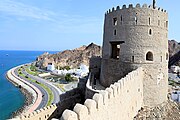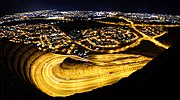Oman
Sultanate of Oman | |
|---|---|
| Anthem:نشيد السلام السلطاني "as-Salām as-Sultānī" "Sultanic Salutation" | |
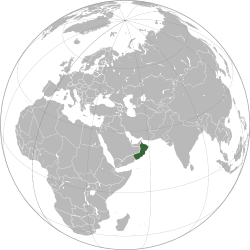 Location of Oman (dark green) | |
| Capital and largest city | Muscat 23°35′20″N58°24′30″E/ 23.58889°N 58.40833°E |
| Official languages | Arabic[1] |
| Religion (2024) | |
| Demonym(s) | Omani |
| Government | Unitary Islamicabsolute monarchy |
| Haitham bin Tariq | |
| Theyazin bin Haitham | |
| Legislature | Council of Oman |
| Council of State (Majlis al-Dawla) | |
| Consultative Assembly (Majlis al-Shura) | |
| Establishment | |
•Azdtribe migration | 130 |
• Al-Julanda | 629 |
| 751 | |
| 1154 | |
| 1507–1656 | |
| 1624 | |
| 1744 | |
| 8 January 1856 | |
• Sultanate of Oman | 9 August 1970 |
| 6 November 1996 (established); 2011 (amended); 2021 (amended)[4] | |
| Area | |
• Total | 309,500 km2(119,500 sq mi) (70th) |
• Water (%) | negligible |
| Population | |
• 2021 estimate | 4,520,471[5][6](125th) |
• 2010 census | 2,773,479[7] |
• Density | 15/km2(38.8/sq mi) (177th) |
| GDP(PPP) | 2023 estimate |
• Total | |
• Per capita | |
| GDP(nominal) | 2023 estimate |
• Total | |
• Per capita | |
| Gini(2018) | 30.75[9] medium inequality |
| HDI(2022) | very high(59th) |
| Currency | Omani rial(OMR) |
| Time zone | UTC+4(GST) |
| DSTis not observed. | |
| Date format | dd.mm.yyyy |
| Drives on | right |
| Calling code | +968 |
| ISO 3166 code | OM |
| Internet TLD | .om,عمان. |
Website www.oman.om | |
Oman,[b]officially theSultanate of Oman,[c]is a country on the southeastern coast of theArabian PeninsulainWestern Asia.It overlooks the mouth of thePersian Gulf.It shares land borders withSaudi Arabia,theUnited Arab Emirates,andYemen.The capital and largest city isMuscat.Oman has a population of about 5.28 million as of 2024, which is a 4.60% population increase from 2023.[11]and is the123rd most-populous country.The coast faces theArabian Seaon the southeast, and theGulf of Omanon the northeast. TheMadhaandMusandamexclavesare surrounded by United Arab Emirates on their land borders, with theStrait of Hormuz(which it shares with Iran) and the Gulf of Oman forming Musandam's coastal boundaries.
From the 17th century, the OmaniSultanatewasan empire,vying with thePortugueseandBritishempires for influence in the Persian Gulf and the Indian Ocean. At its peak in the 19th century, Omani influence and control extended across the Strait of Hormuz to Iran and Pakistan, and as far south asZanzibar.[12]In the 20th century, the sultanate came under the influence of theUnited Kingdom.For over 300 years, the relations built between the two empires were based on mutual benefit. The UK recognized Oman's geographical importance as a trading hub that secured British trading-lanes in thePersian Gulfand Indian Ocean and protected London's interests in the Indian sub-continent. Oman is anabsolute monarchyled by asultan,with power passed down through the male line.Qaboos bin Saidwas the Sultan from 1970 until his death on 10 January 2020.[13]Qaboos, who died childless, had named his cousin,Haitham bin Tariq,as his successor in a letter, and the ruling family confirmed him as the new Sultan of Oman.[14]
Formerly a maritime empire, Oman is the oldest continuously independent state in theArab world.[15][16]It is a member of theUnited Nations,theArab League,theGulf Cooperation Council,theNon-Aligned Movement,and theOrganisation of Islamic Cooperation.It has oil reserves ranked 22nd globally.[15][17]In 2010, theUnited Nations Development Programmeranked Oman as the most-improved country in the world in terms of development during the preceding 40 years.[18]A portion of its economy involvestourismand trading fish,datesand other agricultural produce. TheWorld Bankcategorizes Oman as ahigh-income economyand as of 2023[update]Oman ranks as the 48th most peaceful country in the world according to theGlobal Peace Index.[19]
Etymology
[edit]The oldest known written mention of "Oman" is on a tomb in theMleiha Archeological Centerin the United Arab Emirates.[20] The name "Oman" is thought to be several centuries older thanPliny the Elder’s reference to "Omana"[21]orPtolemy's reference to "Omanon". (Ὄμανον ἐμπόριονinGreek),[22]Both of those references are probably to the ancientSohar.[23]The city or region is typically etymologized in Arabic as deriving fromʿāminorʿamūn('settled' people, as opposed to the nomadicBedouin).[23]Although some have proposed one or another eponymous founder (Oman bin Ibrahim al-Khalil, Oman bin Siba' bin Yaghthan bin Ibrahim, Oman bin Qahtan), others have suggested that "Oman" derives from the name of a valley in Yemen atMa'rib,presumed to be the original home of the city's founders, theAzd,an ancient Bedouin tribe mentioned in thepre-Islamicinscriptions — specifically,Sabaicinscriptions fromSha'r Awtar's reign (210–230CE).[24]
History
[edit]Prehistory and ancient history
[edit]
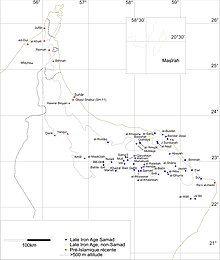
At Aybut Al Auwal, in theDhofar Governorateof Oman, a site was discovered in 2011 containing more than 100 surface scatters of stone tools, belonging to a regionally specific Africanlithic industry—the lateNubianComplex—known previously only from the northeast andHorn of Africa.Two optically stimulated luminescence age estimates place the Arabian Nubian Complex at 106,000 years old. This supports the proposition that early human populations moved from Africa into Arabia during theLate Pleistocene.[25]
In recent years surveys have uncovered Palaeolithic and Neolithic sites on the eastern coast. Main Palaeolithic sites include Saiwan-Ghunaim in the Barr al-Hikman.[26]Archaeological remains are particularly numerous for the Bronze AgeUmm an-NarandWadi Suqperiods. At the archaeological sites of Bat, Al-Janah, and Al-Ayn wheel-turned pottery, hand-made stone vessels, metals industry artifacts, and monumental architecture have been preserved.[27]
There is considerable agreement in sources thatfrankincensewas used by traders in 1500 BCE. TheLand of Frankincense,aUNESCO World Heritage site,dramatically illustrates that the incense constituted testimony toSouth Arabiancivilizations.
During the 8th century BCE, it is believed that the Yaarub, the descendant ofQahtan,ruled the entire region of Yemen, including Oman. Wathil bin Himyar binAbd-Shams (Saba)bin Yashjub (Yaman) bin Yarub binQahtanlater ruled Oman.[28]It is thus believed that the Yaarubah were the first settlers in Oman from Yemen.[29]
In the 1970s and 1980s, scholars likeJohn C. Wilkinson[30]believed by virtue of oral history that in the 6th century BCE, theAchaemenidsexerted control over the Omani peninsula, most likely ruling from a coastal centre such asSuhar.[31]Central Oman has its own indigenous Samad Late Iron Age cultural assemblage named eponymously fromSamad al-Shan.In the northern part of the Oman Peninsula theRecent Pre-Islamic Periodbegins in the 3rd century BCE and extends into the 3rd century CE. Whether or not Persians brought south-eastern Arabia under their control is a moot point, since the lack of Persian archeological finds speak against this belief.Armand-Pierre Caussin de Percevalsuggests that Shammir bin Wathil bin Himyar recognized the authority ofCyrus the Greatover Oman in 536 BCE.[28]
Sumeriantablets referred to Oman as "Magan"[32][33]and in theAkkadian language"Makan",[34][35]a name that links Oman's ancient copper resources.[36]
Western Arabian settlement
[edit]Over centuries tribes from western Arabia settled in Oman, making a living by fishing, farming, herding or stock breeding, and many present day Omani families trace their ancestral roots to other parts of Arabia. Arab migration to Oman started from northern-western and south-western Arabia and those who chose to settle had to compete with the indigenous population for the best arable land. When Arab tribes started to migrate to Oman, there were two distinct groups. One group, a segment of theAzdtribe migrated fromYemenin 120[37]/200 CE following the collapse ofMarib Dam,while the other group migrated a few centuries before the birth of Islam fromNejd(present-daySaudi Arabia), namedNizari.Other historians believe that the Yaarubah from Qahtan, which belong to an older branch, were the first settlers of Oman from Yemen, and then came the Azd.[29]

The Azd settlers in Oman are descendants of Nasr bin Azd and were later known as "the Al-Azd of Oman".[37]Seventy years after the first Azd migration, another branch ofAlazdiunder Malik bin Fahm, the founder of Kingdom ofTanukhiteson the west ofEuphrates,is believed to have settled in Oman.[37]According to Al-Kalbi, Malik bin Fahm was the first settler of Alazd.[38]He is said to have first settled inQalhat.By this account, Malik, with an armed force of more than 6000 men and horses, fought against theMarzban,who served an ambiguously named Persian king in the battle of Salut in Oman and eventually defeated the Persian forces.[29][39][40][41]This account is, however, semi-legendary and seems to condense multiple centuries of migration and conflict as well as an amalgamation of various traditions from not only the Arab tribes but also the region's original inhabitants.[39][42][43]
In the 7th century CE, Omanis came in contact with and acceptedIslam.[44][45]The conversion of Omanis to Islam is ascribed toAmr ibn al-As,who was sent by the prophetMuhammadduring theExpedition of Zaid ibn Haritha (Hisma).Amer was dispatched to meet with Jaifer and Abd, the sons of Julanda who ruled Oman. They appear to have readily embraced Islam.[46]
Imamate of Oman
[edit]OmaniAzdused to travel toBasrafor trade, which was a centre of Islam, during theUmayyadempire. Omani Azd were granted a section of Basra, where they could settle and attend to their needs. Many of the Omani Azd who settled in Basra became wealthy merchants and, under their leaderMuhallab bin Abi Sufrah,started to expand their influence of power eastwards towardsKhorasan.IbadhiIslam originated in Basra through its founder,Abdullah ibn Ibadh,around the year 650 CE; the Omani Azd in Iraq would subsequently adopt this as their predominant faith. Later,Al-hajjaj,the governor of Iraq, came into conflict with the Ibadhis, which forced them back to Oman. Among those who returned was the scholarJaber bin Zaid.His return (and the return of many other scholars) greatly enhanced the Ibadhi movement in Oman.[47]Alhajjaj also made an attempt to subjugate Oman, then ruled by Suleiman and Said (the sons of Abbad bin Julanda). Alhajjaj dispatched Mujjaah bin Shiwah, who was confronted by Said bin Abbad. This confrontation devastated Said's army, after which he and his forces retreated to theJebel Akhdar(mountains). Mujjaah and his forces went after Said, successfully flushing them out from hiding in Wadi Mastall. Mujjaah later moved towards the coast, where he confronted Suleiman bin Abbad. The battle was won by Suleiman's forces. Alhajjaj, however, sent another force (under Abdulrahman bin Suleiman); he eventually won the war, taking over the governance of Oman.[48][49][50]
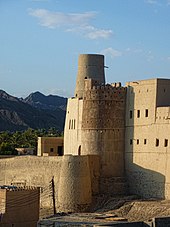
The first electiveImamate of Omanis believed to have been established shortly after the fall of theUmayyad Dynastyin 750/755 CE, when Janaħ bin ʕibadah Alħinnawi was elected.[47][51]Other scholars claim that Janaħ bin Ibadah served as aWāli(governor) under theUmayyaddynasty (and later ratified the Imamate), and that Julanda bin Masud was the first elected Imam of Oman, in 751 CE.[52][53]The first Imamate reached its peak power in the ninth century CE.[47]The Imamate established a maritime empire whose fleet controlled the Gulf, during the time when trade with theAbbasid Dynasty,the Far East, and Africa flourished.[54]The authority of the Imams started to decline due to power struggles, the constant interventions of Abbasid, and the rise of theSeljuk Empire.[55][52]
Nabhani dynasty
[edit]During the 11th and 12th centuries, the Omani coast was in the sphere of influence of theSeljuk Empire.They were expelled in 1154, when the Nabhani dynasty came to power.[55]The Nabhanis ruled asmuluk,or kings, while the Imams were reduced to largely symbolic significance. The capital of the dynasty wasBahla.[56]The Banu Nabhan controlled the trade in frankincense on the overland route viaSoharto theYabrinoasis, and then north to Bahrain, Baghdad and Damascus.[57]The mango-tree was introduced to Oman during the time of Nabhani dynasty, by ElFellah bin Muhsin.[29][58]The Nabhani dynasty started to deteriorate in 1507 when Portuguese colonisers captured the coastal city ofMuscat,and gradually extended their control along the coast up toSoharin the north and down toSurin the southeast.[59]Other historians argue that the Nabhani dynasty ended earlier in 1435 CE when conflicts between the dynasty and Alhinawis arose, which led to the restoration of the elective Imamate.[29]
Portuguese era
[edit]
A decade afterVasco da Gamasucceeded in his voyage around theCape of Good Hopeand to India in 1497–1498, the Portuguese arrived in Oman andoccupied Muscatfor a 143-year period, from 1507 to 1650. In need of an outpost to protect their sea lanes, the Portuguese built up and fortified the city. Remnants of Portuguese architectural style still exist. Later, several more Omani cities were colonized in the early 16th century by the Portuguese, to control the entrances of thePersian Gulfand trade in the region as part of a web of fortresses in the region, fromBasratoHormuz Island.
However, in 1552 anOttoman fleetbrieflycaptured the fort in Muscat,during their fight for control of the Persian Gulf and the Indian Ocean, but soon departed after destroying the surroundings of the fortress.[60]
Later in the 17th century, using its bases in Oman, Portugal engaged in thelargest naval battle ever fought in the Persian Gulf.ThePortugueseforce fought against a combined armada of theDutch East India Company(VOC) andEnglish East India Companysupported by the Safavid empire. The result of the battle was a draw but it resulted in the loss of Portuguese influence in the Gulf.[61]
Yaruba dynasty (1624–1744)
[edit]
TheOttoman Empiretemporarily captured Muscat from the Portuguese again in 1581 and held it until 1588. During the 17th century, the Omanis were reunited by theYaruba Imams.Nasir bin Murshid became the first Yaarubah Imam in 1624, when he was elected in Rustaq.[63]Imam Nasir and his successor succeeded in the 1650s in expelling the Portuguese from their coastal domains in Oman.[47]The Omanis over time established a maritime empire that pursued the Portuguese and expelled them from all their possessions in East Africa, which were then incorporated into the Omani domains. To capture ZanzibarSaif bin Sultan,theImamof Oman, pressed down theSwahili Coast.A major obstacle to his progress wasFort Jesus,housing the garrison of a Portuguese settlement atMombasa.After a two-year siege, the fort fell to Imam Saif bin Sultan in 1698. Saif bin Sultan occupied Bahrain in 1700. The rivalry within the house of Yaruba over power after the death of Imam Sultan in 1718 weakened the dynasty. With the power of the Yaruba Dynasty dwindling, Imam Saif bin Sultan II eventually asked for help against his rivals fromNader Shahof Persia. A Persian force arrived in March 1737 to aid Saif. From their base at Julfar, the Persian forces eventually rebelled against the Yaruba in 1743. The Persian empire then tried to take possession of the coast of Oman until 1747.[47][64]
18th and 19th centuries
[edit]
After the Omanis expelled thePersians,Ahmed bin Sa'id Albusaidi became the elected Imam of Oman in 1749, withRustaqserving as the capital. Since the revival of the Imamate with the Yaruba dynasty, the Omanis continued with the elective system but, provided that the person is deemed qualified, gave preference to a member of the ruling family.[65]Following Imam Ahmed's death in 1783, his son, Said bin Ahmed became the elected Imam. His son, Seyyid Hamed bin Said, overthrew the representative of his father the Imam in Muscat and obtained the possession of Muscat fortress. Hamed ruled as "Seyyid". Afterwards, Seyyid Sultan bin Ahmed, the uncle of Seyyid Hamed, took over power. SeyyidSaid bin Sultansucceeded Sultan bin Ahmed.[66][67]During the entire 19th century, in addition to Imam Said bin Ahmed who retained the title until he died in 1803,Azzan bin Qaiswas the only elected Imam of Oman. His rule started in 1868. However, the British refused to accept Imam Azzan as a ruler, as he was viewed as inimical to their interests. This view played an instrumental role in supporting the deposition of Imam Azzan in 1871 by his cousin, Sayyid Turki, a son of the late Sayyid Said bin Sultan, and brother ofSultan Barghash of Zanzibar,who Britain deemed to be more acceptable.[68]
Oman's Imam Sultan, defeated ruler of Muscat, was granted sovereignty overGwadar,an area of modern-day Pakistan.[note 1][69]
British de facto colonisation
[edit]TheBritish empirewas keen to dominate southeast Arabia to stifle the growing power of other European states and to curb the Omani maritime power that grew during the 17th century.[70][54]The British empire over time, starting from the late 18th century, began to establish a series of treaties with the sultans with the objective of advancing British political and economic interest in Muscat, while granting the sultans military protection.[54][70]In 1798, the first treaty between the BritishEast India Companyand the Albusaidi dynasty was signed by Sayyid Sultan bin Ahmed. The treaty aimed to block commercial competition of the French and the Dutch as well as obtain a concession to build a British factory atBandar Abbas.[71][47][72]A second treaty was signed in 1800, which stipulated that a British representative shall reside at the port of Muscat and manage all external affairs with other states.[72]As the Omani Empire weakened, the British influence over Muscat grew throughout the nineteenth century.[62]
In 1854, a deed of cession of the OmaniKuria Muriaislands to Britain was signed by the sultan of Muscat and the British government.[74]The British government achieved predominating control over Muscat, which, for the most part, impeded competition from other nations.[75]Between 1862 and 1892, the Political Residents,Lewis Pellyand Edward Ross, played an instrumental role in securing British supremacy over the Persian Gulf and Muscat by a system of indirect governance.[68]By the end of the 19th century, and with the loss of its African dominions and its revenues, British influence increased to the point that the sultans became heavily dependent on British loans and signed declarations to consult the British government on all important matters.[70][76][77][78]The Sultanate thus camede factounder the British sphere.[77][79]
Zanzibar was a valuable property as the mainslave marketof the Swahili Coast as well as being a major producer of cloves, and became an increasingly important part of the Omani empire, a fact reflected by the decision of the SayyidSa'id bin Sultan,to make it the capital of the empire in 1837. In 1856, under British arbitration, Zanzibar and Muscat became two different sultanates.[80]
Treaty of Seeb
[edit]
TheHajar Mountains,of which theJebel Akhdaris a part, separate the country into two distinct regions: the interior, and the coastal area dominated by the capital, Muscat.[citation needed]The British imperial development over Muscat and Oman during the 19th century led to the renewed revival of the cause of the Imamate in the interior of Oman, which has appeared in cycles for more than 1,200 years in Oman.[54]The British Political Agent, who resided in Muscat, owed the alienation of the interior of Oman to the vast influence of the British government over Muscat, which he described as being completely self-interested and without any regard to the social and political conditions of the locals.[81]In 1913, Imam Salim Alkharusi instigated an anti-Muscat rebellion that lasted until 1920 when the Sultanate established peace with the Imamate by signing theTreaty of Seeb.The treaty was brokered by Britain, which had no economic interest in the interior of Oman during that point of time. The treaty granted autonomous rule to the Imamate in the interior of Oman and recognized the sovereignty of the coast of Oman, theSultanate of Muscat.[70][82][83][84]In 1920, Imam Salim Alkharusi died and Muhammad Alkhalili was elected.[47]
On 10 January 1923, an agreement between the Sultanate and the British government was signed in which the Sultanate had to consult with the Britishpolitical agentresiding in Muscat and obtain the approval of theHigh Government of Indiato extract oil in the Sultanate.[85]On 31 July 1928, theRed Line Agreementwas signed between Anglo-Persian Company (later renamed British Petroleum), Royal Dutch/Shell, Compagnie Française des Pétroles (later renamed Total), Near East Development Corporation (later renamed ExxonMobil) and Calouste Gulbenkian (an Armenian businessman) to collectively produce oil in the post-Ottoman Empireregion, which included the Arabian peninsula, with each of the four major companies holding 23.75 percent of the shares whileCalouste Gulbenkianheld the remaining 5 percent shares. The agreement stipulated that none of the signatories was allowed to pursue the establishment of oil concessions within the agreed on area without including all other stakeholders. In 1929, the members of the agreement establishedIraq Petroleum Company(IPC).[86]On 13 November 1931, Sultan Taimur bin Faisal abdicated.[87]
Reign of Sultan Said (1932–1970)
[edit]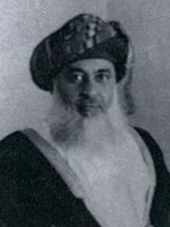
Said bin Taimurbecame the sultan of Muscat officially on 10 February 1932. The rule of sultan Said, a very complex character, was backed by the British government, and has been characterised as beingfeudal,reactionaryand isolationist.[84][54][77][88]The British government maintained vast administrative control over the Sultanate as the defence secretary and chief of intelligence, chief adviser to the sultan and all ministers except for two were British.[77][89]In 1937, an agreement between the sultan andIraq Petroleum Company(IPC), a consortium of oil companies that was 23.75% British owned, was signed to grant oil concessions to IPC. After failing to discover oil in the Sultanate, IPC was intensely interested in some promising geological formations nearFahud,an area located within the Imamate. IPC offered financial support to the sultan to raise an armed force against any potential resistance by the Imamate.[90][91]
Upon the outbreak ofWorld War II,the sultan of Oman declared war on Germany on September 10, 1939.[92]During the war, Oman had a strategic role in the defence of the United Kingdom's trade routes. Oman was never attacked during the war. In 1943, theRoyal Air Forceestablished stations onMasirah Island(RAF Masirah) and atRas al Hadd.Air-sea rescueunits were also stationed in Oman.No. 244 Squadron RAFflewBristol Blenheim Vlight bombersandVickers Wellington XIIIsout of RAF Masirah on anti-submarine duties in the Gulf of Oman and the northernArabian Sea,whileNo. 209 Squadron RAF,No. 265 Squadron RAF,andNo. 321 Squadron RAFflewConsolidated PBY Catalinasout of Umm Ruşayş on Masirah Island.[93]On October 16, 1943, the GermanU-BoatU-533was sunk in the Gulf of Oman after being struck bydepth chargesdropped by a Bristol Blenheim from No. 244 Squadron RAF. The wreck settled at a depth of 108 meters (354 feet) approximately 25 nautical miles (46 kilometres) off theFujairahcoast. 52 crew members died, with the sole survivor,MatrosengefreiterGünther Schmidt, taken aboard HMISHiravatinearKhor Fakkanand made aprisoner of war.The wreck is now a popular recreational diving site.[94][95]
The December 1951 Treaty of Friendship, Commerce and Navigation (covering commerce, oil reserves and navigation) between Oman and the United Kingdom recognized the Sultanate of Muscat and Oman as a fully independent state.
In 1955, theexclavecoastalMakranstrip acceded to Pakistan and was made a district of itsBalochistan province,whileGwadarremained in Oman. On 8 September 1958, Pakistanpurchased the Gwadar enclavefrom Oman forUS$3 million.[note 2][96]Gwadar then became atehsilin the Makran district.
Jebel Akhdar War
[edit]Sultan Said bin Taimur expressed his interest in occupying the Imamate right after the death of Imam Alkhalili, thus taking advantage of any potential instability that might occur within the Imamate when elections were due, to the British government.[97]The British political agent in Muscat believed that the only method of gaining access to the oil reserves in the interior was by assisting the sultan in taking over the Imamate.[98]In 1946, the British government offered arms and ammunition, auxiliary supplies and officers to prepare the sultan to attack the interior of Oman.[99]In May 1954, Imam Alkhalili died andGhalib Alhinaiwas elected Imam.[100]Relations between the Sultan Said bin Taimur, and Imam Ghalib Alhinai frayed over their dispute about oil concessions.
In December 1955, Sultan Said bin Taimur sent troops of the Muscat and Oman Field Force to occupy the main centres in Oman, includingNizwa,the capital of the Imamate of Oman, andIbri.[82][101]The Omanis in the interior led by Imam Ghalib Alhinai, Talib Alhinai, the brother of the Imam and the Wali (governor) of Rustaq, and Suleiman bin Hamyar, who was the Wali (governor) of Jebel Akhdar, defended the Imamate in theJebel Akhdar Waragainst British-backed attacks by the Sultanate. In July 1957, the Sultan's forces were withdrawing, but they were repeatedly ambushed, sustaining heavy casualties.[82]Sultan Said, however, with the intervention of British infantry (two companies of theCameronians), armoured car detachments from the British Army andRAFaircraft, was able to suppress the rebellion.[102]The Imamate's forces retreated to the inaccessibleJebel Akhdar.[102][90]
ColonelDavid Smiley,who had been seconded to organise the Sultan's Armed Forces, managed to isolate the mountain in autumn 1958 and found a route to the plateau from Wadi Bani Kharus.[103]On 4 August 1957, the British Foreign Secretary gave the approval to carry out air strikes without prior warning to the locals residing in the interior of Oman.[88]Between July and December 1958, the British RAF made 1,635 raids, dropping 1,094 tons and firing 900 rockets at the interior of Oman targeting insurgents, mountain top villages, water channels and crops.[77][88]On 27 January 1959, the Sultanate's forces occupied the mountain in a surprise operation.[103]Imam Ghalib, his brother Talib and Sulaiman managed to escape toSaudi Arabia,where the Imamate's cause was promoted until the 1970s.[103]The exiled partisans of the now abolished Imamate of Oman presented the case of Oman to theArab Leagueand the United Nations.[104][105]On 11 December 1963, the UN General Assembly decided to establish an Ad-Hoc Committee on Oman to study the 'Question of Oman' and report back to the General Assembly.[106]The UN General Assembly adopted the 'Question of Oman' resolution in 1965, 1966 and again in 1967 that called upon the British government to cease all repressive action against the locals, end British control over Oman and reaffirmed the inalienable right of the Omani people to self-determination and independence.[107][108][79][109][110][111]
Dhofar War
[edit]In theDhofar War,which began in 1963, pro-Sovietforces were pitted against government troops. As the rebellion threatened the Sultan's control ofDhofar,Sultan Said bin Taimur was deposed in abloodless coupin 1970 by his sonQaboos bin SaidwithBritishsupport. Qaboos expanded theSultan of Oman's Armed Forces,modernized the state's administration and introduced social reforms. The uprising was finally put down in 1976 with the help of forces from Jordan, Saudi Arabia, Iran, Pakistan and Britain.
Modern history (1970–present)
[edit]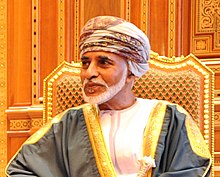
After deposing his father in 1970,Sultan Qaboosopened up the country, removed "Muscat and" from the country's name, embarked on economic reforms, and followed a policy of modernisation marked by increased spending on health, education and welfare.[112]Saudi Arabia invested in the development of the Omani education system, sending Saudi teachers on its own expense.[113][114]Slavery,once a cornerstone of the country's trade and development, was outlawed in 1970.[115]
In 1971, Oman joined the United Nations, as did Bahrain, Qatar and the United Arab Emirates.
In 1981, Oman became a founding member of the six-nationGulf Cooperation Council.Political reforms were eventually introduced. The country adopted its presentnational flagin 1995, resembling the previous flag but with a thicker stripe. In 1997, a royal decree was issued granting women the right to vote, and stand for election to the Majlis al-Shura, theConsultative Assembly of Oman.Two women were duly elected to the body. In 2002, voting rights were extended to all citizens over the age of 21, and the first elections to the Consultative Assembly under the new rules were held in 2003. In 2004, the Sultan appointed Oman's first female minister with portfolio,Sheikha Aisha bint Khalfan bin Jameel al-Sayabiyah,to the post of National Authority for Industrial Craftsmanship.[116]Despite these changes, there was little change to the actual political makeup of the government. The Sultan continued to rule by decree. Nearly 100 suspected Islamists were arrested in 2005 and 31 people were convicted of trying to overthrow the government. They were ultimately pardoned in June of the same year.[15]
Before theBeijing Olympics,Oman became the stop of the Middle East'storch relayon 14 April 2008, covering 20 kilometres.
Inspired by theArab Springuprisings that were taking place throughout the region,protests occurred in Omanduring the early months of 2011. While they did not call for the ousting of the regime, demonstrators demanded political reforms, improved living conditions and the creation of more jobs. They were dispersed by riot police in February 2011. Sultan Qaboos reacted by promising jobs and benefits. In October 2011, elections were held to the Consultative Assembly, to which Sultan Qaboos promised greater powers. The following year, the government began a crackdown on internet criticism. In September 2012, trials began of 'activists' accused of posting "abusive and provocative" criticism of the government online. Six were given jail terms.[117]
In 2013, Oman achieved its status as the elimination ofmalariadiagnoses, according to theWorld Health Organization.
Qaboos, the Arab world's longest-serving ruler, died on 10 January 2020.[118]Leaving no heir on succession, on 11 January 2020 Qaboos was succeeded by his first cousinHaitham bin Tariq.[119]
On 12 January 2021,Theyazin bin Haitham,Sultan Haithan's oldest son became the crown prince as first in line to succeed his father under new fundamental law.
Geography
[edit]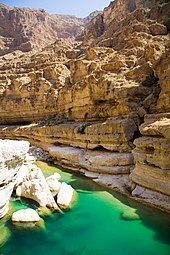
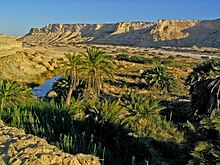
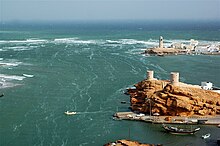
Oman lies between latitudes16th parallel northand28th parallel north,and longitudes52nd meridian eastand60th meridian east.A gravel desert plain covers most of central Oman, with mountain ranges along the north (Hajar Mountains) and southeast coast (Dhofar Mountains),[120][121]where the country's main cities are located: the capital cityMuscat,SoharandSurin the north, andSalalahin the south andMusandam.Oman's climate is hot and dry in the interior and humid along the coast.
The peninsula ofMusandam(Musandem), strategically located on theStrait of Hormuz,is anexclaveseparated from the rest of Oman by theUnited Arab Emirates.[122]
Madha,another exclave, is an enclave within UAE territory located halfway between the Musandam Peninsula and the main body of Oman.[122]Madha, part of the Musandam governorate, covers approximately 75 square kilometres (29 sq mi). Madha's boundary was settled in 1969, with the north-east corner of Madha barely 10 metres (33 ft) from theFujairahroad. Within the Madha exclave is a UAEenclavecalledNahwa,belonging to theEmirate of Sharjah,situated about 8 kilometres (5.0 mi) west of the town of New Madha, and consisting of about forty houses with a clinic and telephone exchange.[123]
The central desert of Oman is a source ofmeteoritesfor scientific analysis.[124]
Climate
[edit]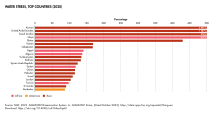
Like the rest of the Persian Gulf, Oman generally has one of the hottest climates in the world—with summer temperatures in Muscat and northern Oman averaging 30 to 40 °C (86.0 to 104.0 °F).[125]Oman receiveslittle rainfall,with annual rainfall in Muscat averaging 100 mm (3.9 in), occurring mostly in January. In the south, theDhofarMountains area near Salalah has a tropical-like climate and receives seasonal rainfall from late June to late September as a result of monsoon winds from the Indian Ocean, leaving the summer air saturated with cool moisture and heavy fog.[126]Summer temperatures inSalalahrange from 20 to 30 °C (68.0 to 86.0 °F)—relatively cool compared to northern Oman.[127]
The mountain areas receive more rainfall, and annual rainfall on the higher parts of theJabal Akhdarprobably exceeds 400 millimetres (16 in).[128]Low temperatures in the mountainous areas leads to snow cover once every few years.[129]Some parts of the coast, particularly near the island ofMasirah,sometimes receive no rain at all within the course of a year. The climate is generally very hot, with temperatures reaching around 54 °C (129.2 °F) (peak) in the hot season, from May to September.[130]
On 26 June 2018 the city ofQurayyatset the record for highest minimum temperature in a 24-hour period, 42.6°C (108.7°F).[131]
In terms of climate action, major challenges remain to be solved, per the United Nations Sustainable Development 2019 index. The CO2 emissions from energy (tCO2/capita) and CO2 emissions embodied in fossil fuel exports (kg per capita) rates are very high, while imported CO2 emissions (tCO2/capita) and people affected by climate-related disasters (per 100,000 people) rates are low.[132]
Biodiversity
[edit]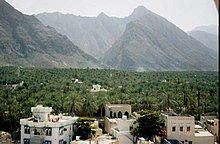

Desert shruband desert grass, common in southern Arabia, are found in Oman, but vegetation is sparse in the interior plateau, which is largelygraveldesert. The greater monsoon rainfall in Dhofar and the mountains makes the growth there more luxuriant during summer;coconut palmsgrow plentifully on the coastal plains of Dhofar andfrankincenseis produced in the hills, with abundantoleanderand varieties ofacacia.The Hajar Mountains are a distinctecoregion,the highest points in eastern Arabia, withwildlifethat includes theArabian tahr.

Indigenousmammalsinclude theleopard,hyena,fox,wolf,hare,oryxandibex.Birds include the vulture, eagle, stork, bustard,Arabian partridge,bee eater,falcon and sunbird. In 2001, Oman had nine endangered species of mammals, five endangered types of birds,[133]and nineteen threatenedplant species.Decreeshave been passed to protect endangered species, including theArabian leopard,Arabian oryx,mountain gazelle,goitered gazelle,Arabian tahr,green sea turtle,hawksbill turtleandolive ridley turtle.However, theArabian Oryx Sanctuaryis the first site ever to be deleted fromUNESCO's World Heritage List, following the government's 2007 decision to reduce the site's area by 90% to clear the way for oil prospectors.[134]
Local and national entities have noted unethical treatment of animals in Oman. In particular, stray dogs (and to a lesser extent, stray cats) are often the victims of torture, abuse or neglect.[135]The only approved method of decreasing the stray dog population is shooting by police officers. The Oman government has refused to implement a spay and neuter programme or create any animal shelters in the country. Cats, while seen as more acceptable than dogs, are nevertheless also viewed as pests and frequently die of starvation or illness.[136][137]
In recent years, Oman has become a popular spot forwhale watching,highlighting the critically endangered Arabianhumpback whale,sperm whalesandpygmy blue whales.[138]
Politics
[edit]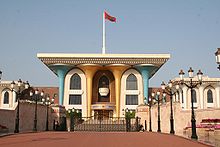
Oman is aunitary stateand anabsolute monarchy,[139]in which all legislative, executive and judiciary power ultimately rests in the hands of the hereditary Sultan. Consequently,Freedom Househas routinely rated the country "Not Free".[140]
The sultan is the head of state and directly controls the foreign affairs and defence portfolios.[141]He has absolute power and issueslaws by decree.[142][143]
Legal system
[edit]Oman is anabsolute monarchy,with the Sultan's word having the force of law. The judiciary branch is subordinate to the Sultan. According to Oman's constitution,Sharia lawis one of the sources of legislation. Sharia court departments within the civil court system are responsible for family-law matters, such as divorce and inheritance.
While ultimate power is concentrated in the Sultan[13]and Oman does not have an officialseparation of powers,[13]the late Sultan Qaboos declined to grant the full title Minister of Defence, Minister of Foreign Affairs and Minister of Finance to the ministers exercising those responsibilities, preferring to keep them within the Royal Domain. The current Sultan Haitham has granted the ministers responsible of those portfolios the full titles, whilst elevating the defense portfolio to that of a deputy prime minister.[13]Since 1970 all legislation has been promulgated through royal decrees, including the 1996 Basic Law.[13]The Sultan appoints the ministers, the judges, and can grant pardons and commute sentences.[13]The Sultan's authority is inviolable and the Sultan expects total subordination to his will.[13]
The administration of justice is highly personalized, with limited due process protections, especially in political and security-related cases.[144]TheBasic Statute of the State[145]is supposedly the cornerstone of the Omani legal system and it operates as a constitution for the country. The Basic Statute was issued in 1996 and thus far has only been amended twice: in 2011,[146]in response toprotests;and in 2021, to create the position ofCrown Prince of Oman.
Though Oman's legal code theoretically protects civil liberties and personal freedoms, both are regularly ignored by the regime.[13]Women and children face legal discrimination in many areas.[13]Women are excluded from certain state benefits, such as housing loans, and are refused equal rights under the personal status law.[13]Women also experience restrictions on their self-determination in respect to health and reproductive rights.[13]
The Omani legislature is the bicameralCouncil of Oman,consisting of an upper chamber, theCouncil of State(Majlis ad-Dawlah) and a lower chamber, theConsultative Assembly(Majlis al-Shura).[147]Political parties are banned, as are any affiliations based on religion.[143]The upper chamber has 71 members, appointed by the Sultan from among prominent Omanis; it has only advisory powers.[148]The 84 members of the Consultative Assembly are elected by universal suffrage to serve four-year terms.[148]The members are appointed for three-year terms, which may be renewed once.[147]The last elections were held on29 October 2023,and the next is due in October 2027. Oman's national anthem,As-Salam as-Sultaniis dedicated to former Sultan Qaboos.
Foreign policy
[edit]
Since 1970, Oman has pursued a moderate foreign policy, and has expanded its diplomatic relations dramatically. Oman is among the very few Arab countries that have maintained friendly ties withIran.[149][150]Yusuf bin Alawi bin Abdullahis the Sultanate's Minister Responsible for Foreign Affairs.
Oman allowed the BritishRoyal NavyandIndian Navyaccess to the port facilities ofAl Duqm Port & Drydock.[151]
Military
[edit]
SIPRI's estimation of Oman's military and security expenditure as a percentage of GDP in 2020 was 11 percent, making it the world's highest rate in that year, higher thanSaudi Arabia(8.4 percent).[152]Oman's on-average military spending as a percentage of GDP between 2016 and 2018 was around 10 percent, while the world's average during the same period was 2.2 percent.[153]
Oman's military manpower totalled 44,100 in 2006, including 25,000 men in the army, 4,200 sailors in the navy, and an air force with 4,100 personnel. TheRoyal Householdmaintained 5,000 Guards, 1,000 in Special Forces, 150 sailors in the Royal Yacht fleet, and 250 pilots and ground personnel in the Royal Flight squadrons. Oman also maintains a modestly sized paramilitary force of 4,400 men.[154]
TheRoyal Army of Omanhad 25,000 active personnel in 2006, plus a small contingent of Royal Household troops. Despite a comparative large military spending, it has been relatively slow to modernise its forces. Oman has a relatively limited number of tanks, including 6M60A1,73M60A3and 38Challenger 2main battle tanks, as well as 37 agingScorpionlight tanks.[154]
TheRoyal Air Force of Omanhas approximately 4,100 men, with 36 combat aircraft and no armed helicopters. Combat aircraft include 20 agingJaguars,12HawkMk 203s, 4 Hawk Mk 103s and 12PC-9turboprop trainers with a limited combat capability. It has one squadron of 12F-16C/D aircraft. Oman also has 4A202-18 Bravosand 8MFI-17B Mushshaqs.[154]
TheRoyal Navy of Omanhad 4,200 men in 2000, and is headquartered atSeeb.It has bases at Ahwi, Ghanam Island,MussandamandSalalah.In 2006, Oman had ten surface combat vessels. These included two 1,450-tonQahirclasscorvettes,and eight ocean-goingpatrol boats.The Omani Navy had one 2,500-tonNasr al BahrclassLSL (240 troops, 7 tanks) with a helicopter deck. Oman also had at least fourlanding craft.[154]Oman ordered threeKhareefclasscorvettes from theVT Groupfor £400 million in 2007. They were built atPortsmouth.[155]In 2010 Oman spent US$4.074 billion on military expenditures, 8.5%of the gross domestic product.[156]The sultanate has a long history of association with the British military and defence industry.[157]According toSIPRI,Oman was the 23rd largest arms importer from 2012 to 2016.[158]
Human rights
[edit]Torture methods in use in Oman includemock execution,beating,hooding,solitary confinement, subjection to extremes of temperature and to constant noise, abuse and humiliation.[159][160]There have been numerous reports of torture and other inhumane forms of punishment perpetrated by Omani security forces on protesters and detainees.[161]Several prisoners detained in 2012 complained of sleep deprivation, extreme temperatures and solitary confinement.[162]Homosexualityis criminalised within Oman.[163]

The Omani government decides who can or cannot be a journalist and this permission can be withdrawn at any time.[165]Censorship andself-censorshipare a constant factor.[165]Omanis have limited access to political information through the media.[166]Access to news and information can be problematic: journalists have to be content with news compiled by the official news agency on some issues.[165]Through a decree by the Sultan, the government has now extended its control over the media to blogs and other websites.[165]Omanis cannot hold a public meeting without the government's approval.[165]Omanis who want to set up a non-governmental organisation of any kind need a licence.[165]The Omani government does not permit the formation of independentcivil societyassociations.[161]Human Rights Watchissued in 2016, that an Omani court sentenced three journalists to prison and ordered the permanent closure of their newspaper, over an article that alleged corruption in the judiciary.[167]
Omani law prohibits criticism of the Sultan and government in any form or medium.[165]Oman's police do not needsearch warrantsto enter people's homes.[165]The law does not provide citizens with the right to change their government.[165]The Sultan retains ultimate authority on all foreign and domestic issues.[165]Government officials are not subject to financial disclosure laws.[165]Criticism of government figures and politically objectionable views have been suppressed.[165]Publication of books is limited and the government restricts their importation and distribution, as with other media products.[165]
Until 2023, Omani citizens needed government permission to marry foreigners.[162]In April 2023 the law was changed by a royal decree, allowing Omani citizens to marry foreigners without government permission.[168]According to HRW, women in Oman face discrimination.[164]
The plight ofdomestic workersin Oman is a taboo subject.[169][170]In 2011, thePhilippinesgovernment determined that out of all the countries in the Middle East, only Oman and Israel qualify as safe for Filipino migrants.[171][170]Migrant workers remained insufficiently protected against exploitation.[172]
Administrative divisions
[edit]
The Sultanate is administratively divided into eleven governorates. Governorates are, in turn, divided into 60wilayats.[173][174]
- Ad Dakhiliyah
- Ad Dhahirah
- Al Batinah North
- Al Batinah South
- Al Buraimi
- Al Wusta
- Ash Sharqiyah North
- Ash Sharqiyah South
- Dhofar
- Muscat
- Musandam
Economy
[edit]
Oman's Basic Statute of the State expresses in Article 11 that the "national economy is based on justice and the principles of afree economy".[175]By regional standards, Oman has a relatively diversified economy, but remains dependent on oil exports. In terms of monetary value, mineral fuels accounted for 82.2 percent of total product exports in 2018.[176]Tourism is the fastest-growing industry in Oman. Other sources of income, agriculture and industry, are small in comparison and account for less than 1% of the country's exports, but diversification is seen as a priority by the government. Agriculture, oftensubsistencein its character, producesdates,limes,grainsand vegetables, but with less than 1% of the country undercultivation,Oman is likely to remain a net importer of food.
Oman's socio-economic structure is described as being hyper-centralizedrentierwelfare state.[177]The largest 10 percent of corporations in Oman are the employers of almost 80 percent of Omani nationals in the private sector. Half of the private sector jobs are classified as elementary. One third of employed Omanis are in the private sector, while the remaining majority are in the public sector.[178]A hyper-centralized structure produces a monopoly-like economy, which hinders having a healthy competitive environment between businesses.[177]
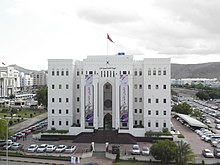
Since a slump in oil prices in 1998, Oman has made active plans to diversify its economy and is placing a greater emphasis on other areas of industry, namely tourism and infrastructure. Oman had a 2020 Vision to diversify the economy established in 1995, which targeted a decrease in oil's share to less than 10 percent of GDP by 2020, but it was rendered obsolete in 2011. Oman then established 2040 Vision.[177]Afree-trade agreement with the United Statestook effect 1 January 2009, eliminated tariff barriers on all consumer and industrial products, and also provided strong protections for foreign businesses investing in Oman.[179]Tourism,another source of Oman's revenue, is on the rise.[180]
Foreign Direct Investment (FDI) in Oman by country as of 2017[181]
Oman'sforeign workerssend an estimated US$10 billion annually to their home states in Asia and Africa, more than half of them earning a monthly wage of less than US$400.[182]The largest foreign community is from the Indian states ofKerala,Tamil Nadu,Karnataka,Maharashtra,Gujaratand thePunjab,[183]representing more than half of entire workforce in Oman. Salaries for overseas workers are known to be less than for Omani nationals, though still from two to five times higher than for the equivalent job in India.[182]
In terms of foreign direct investment (FDI), total investments in 2017 exceeded US$24 billion. The highest share of FDI went to the oil and gas sector, which represented around US$13billion (54.2 percent), followed byfinancial intermediation,which represented US$3.66 billion (15.3 percent). FDI is dominated by the United Kingdom with an estimated value of US$11.56billion (48 percent), followed by the UAE US$2.6 billion (10.8 percent), followed by Kuwait US$1.1 billion (4.6 percent).[181]
Oman in 2018 had a budget deficit of 32 percent of total revenue and a government debt to GDP of 47.5 percent.[184][185]Oman's military spending to GDP between 2016 and 2018 averaged 10 percent, while the world's average during the same period was 2.2 percent.[186]Oman's health spending to GDP between 2015 and 2016 averaged 4.3 percent, while the world's average during the same period was 10 percent.[187]Oman's research and development spending between 2016 and 2017 averaged 0.24 percent, which is significantly lower than the world's average (2.2 percent) during the same period.[188]Oman's government spending on education to GDP in 2016 was 6.11 percent, while the world's average was 4.8 percent (2015).[189]
| Type | Spending (% of GDP)[190][191][192][193] |
|---|---|
| Military spending | |
| Education spending | |
| Health spending | |
| Research & Development spending |
Oil and gas
[edit]
Oman's proved reserves of petroleum total about 5.5 billion barrels, 25th largest in the world.[149]Oil is extracted and processed byPetroleum Development Oman(PDO), with proven oil reserves holding approximately steady, although oil production has been declining.[194][195]TheMinistry of Energy and Mineralsis responsible for all oil and gas infrastructure and projects in Oman.[196]Following the1970s energy crisis,Oman doubled their oil output between 1979 and 1985.[197]
In 2018, oil and gas represented 71 percent of the government's revenues.[184]In 2016, oil and gas share of the government's revenue represented 72 percent.[198]The government's reliance on oil and gas as a source of income dropped by 1 percent from 2016 to 2018. Oil and gas sector represented 30.1 percent of the nominal GDP in 2017.[199]
Between 2000 and 2007, production fell by more than 26%, from 972,000 to 714,800barrels per day.[200]Production has recovered to 816,000 barrels in 2009, and 930,000 barrels per day in 2012.[200]Oman's natural gas reserves are estimated at 849.5 billion cubic metres, ranking 28th in the world, and production in 2008 was about 24 billion cubic metres per year.[149]
In September 2019, Oman was confirmed to become the first Middle Eastern country to host theInternational Gas UnionResearch Conference (IGRC 2020). This 16th iteration of the event will be held between 24 and 26 February 2020, in collaboration withOman LNG,under the auspices of theMinistry of Energy and Minerals.[201]
Industry, innovation and infrastructure
[edit]In industry, innovation and infrastructure, Oman is still faced with "significant challenges", as per United Nations Sustainable Development Goals index, as of 2019. Oman has scored high on the rates of internet use, mobile broadband subscriptions, logistics performance and on the average of top 3 university rankings. Meanwhile, Oman scored low on the rate of scientific and technical publications and on research & development spending.[132]Oman's manufacturing value added to GDP rate in 2016 was 8.4 percent, which is lower than the average in the Arab world (9.8 percent) and world average (15.6 percent). In terms of research & development expenditures to GDP, Oman's share was on average 0.20 percent between 2011 and 2015, while the world's average during the same period was 2.11 percent.[202]The majority of firms in Oman operate in the oil and gas, construction and trade sectors.[203]
| Non-hydrocarbon GDP growth | 2015 | 2016 | 2017 | 2018 |
|---|---|---|---|---|
| Value (%)[204] | 4.8 | 6.2 | 0.5 | 1.5 |
Oman is refurbishing and expanding the ports infrastructure in Muscat, Duqm, Sohar and Salalah to expand tourism, local production and export shares. Oman is also expanding its downstream operations by constructing a refinery and petrochemical plant in Duqm with a 230,000 barrels per day capacity projected for completion by 2021.[181]The majority of industrial activity in Oman takes place in 8 industrial states and 4 free-zones. The industrial activity is mainly focused on mining-and-services, petrochemicals and construction materials.[203]The largest employers in the private-sector are the construction, wholesale-and-retail and manufacturing sectors, respectively. Construction accounts for nearly 48 percent of the total labour force, followed by wholesale-and-retail, which accounts for around 15 percent of total employment and manufacturing, which accounts for around 12 percent of employment in the private sector. The percentage of Omanis employed in the construction and manufacturing sectors is nevertheless low, as of 2011 statistics.[178]
Oman, as perGlobal Innovation Index(2019) report, scores "below expectations" in innovation relative to countries classified under high income.[205]Oman in 2019 ranked 80 out of 129 countries in innovation index, which takes into consideration factors, such as, political environment, education, infrastructure and business sophistication.[206]Innovation, technology-based growth and economic diversification are hindered by an economic growth that relies on infrastructure expansion, which heavily depends on a high percentage of 'low-skilled' and 'low-wage' foreign labour. Another challenge to innovation is theDutch diseasephenomenon, which creates an oil and gas investment lock-in, while relying heavily on imported products and services in other sectors. Such a locked-in system hinders local business growth and global competitiveness in other sectors, and thus impedes economic diversification.[203]The inefficiencies and bottlenecks in business operations that are a result of heavy dependence on natural resources and 'addiction' to imports in Oman suggest a 'factor-driven economy'.[178]A third hindrance to innovation in Oman is an economic structure that is heavily dependent on few large firms, while granting few opportunities for SMEs to enter the market, which impedes healthy market-share competition between firms.[203]The ratio of patent applications per million people was 0.35 in 2016 and theMENAregion average was 1.50, while the 'high-income' countries' average was approximately 48.0 during the same year.[207]Oman was ranked 69th in theGlobal Innovation Indexin 2023.[208]
Agriculture and fishing
[edit]Oman's fishing industry contributed 0.78 percent to the GDP in 2016. Fish exports between 2000 and 2016 grew from US$144 million to US$172 million (+19.4 percent). The main importer of Omani fish in 2016 was Vietnam, which imported almost US$80 million (46.5 percent) in value, and the second biggest importer was the United Arab Emirates, which imported around US$26 million (15 percent). The other main importers are Saudi Arabia, Brazil and China. Oman's consumption of fish is almost two times the world's average. The ratio of exported fish to total fish captured in tons fluctuated between 49 and 61 percent between 2006 and 2016. Omani strengths in the fishing industry comes from having a good market system, a long coastline (3,165 km) and wide water area. Oman, on the other hand, lacks sufficient infrastructure, research and development, quality and safety monitoring, together with a limited contribution by the fishing industry to GDP.[209]
Datesrepresent 80 percent of all fruit crop production. Further, date farms employ 50 percent of the total agricultural area in the country. Oman's estimated production of dates in 2016 is 350,000 tons, making it the 9th largest producer of dates. Oman's total export of dates was US$12.6 million in 2016, almost equivalent to Oman's total imported value of dates, which was US$11.3 million in 2016. The main importer is India (around 60 percent of all imports). Oman's date exports remained steady between 2006 and 2016. Oman is considered to have good infrastructure for date production and support provision to cultivation and marketing, but lacks innovation in farming and cultivation, industrial coordination in the supply chain and encounter high losses of unused dates.[209]
Tourism
[edit]

Tourism in Oman has grown considerably recently, and it is expected to be one of the largest industries in the country.[210]The World Travel & Tourism Council stated that Oman is the fastest growing tourism destination in the Middle East.[211]
Tourism contributed 2.8 percent to the Omani GDP in 2016. It grew from RO 505 million (US$1.3 billion) in 2009 to RO 719 million (US$1.8 billion) in 2017 (+42.3 percent growth). Citizens of the Gulf Cooperation Council (GCC), including Omanis who are residing outside of Oman, represent the highest ratio of all tourists visiting Oman, estimated to be 48 percent. The second highest number of visitors come from other Asian countries, who account for 17 percent of the total number of visitors.[209]A challenge to tourism development in Oman is the reliance on the government-owned firm, Omran, as a key actor to develop the tourism sector, which potentially creates a marketbarrier-to-entryof private-sector actors and acrowding outeffect. Another key issue to the tourism sector is deepening the understanding of the ecosystem and biodiversity in Oman to guarantee their protection and preservation.[203]
Ecotourismis a growing segment of Omani tourism.[212]One site in particular –Ras al-Jinz,also known as "Turtle Beach" – is a popular destination due to the annual nesting of the critically endangeredHawksbill Turtle,the endangeredGreen Turtle,theOlive Ridley Turtle,and theLoggerhead Turtle.[213]
Oman has one of the most diverse environments in the Middle East with various tourist attractions and is particularly well known for adventure andcultural tourism.[180][214]Muscat,the capital of Oman, was named the second best city to visit in the world in 2012 by the travel guide publisherLonely Planet.[215]Muscat also was chosen as the Capital of Arab Tourism of 2012.[216]
In November 2019, Oman made the rule ofvisaon arrival an exception and introduced the concept of e-visa for tourists from all nationalities. Under the new laws, visitors were required to apply for the visa in advance.[217]
Demographics
[edit]| Year | Pop. | ±% p.a. |
|---|---|---|
| 1950 | 457,000 | — |
| 1960 | 537,000 | +1.63% |
| 1970 | 671,000 | +2.25% |
| 1980 | 1,017,000 | +4.25% |
| 1990 | 1,805,000 | +5.90% |
| 2000 | 2,344,000 | +2.65% |
| 2010 | 2,882,000 | +2.09% |
| 2015 | 4,192,000 | +7.78% |
| 2020 | 4,543,000 | +1.62% |
| 2023 | 4,644,384 | +0.74% |
| source:[5][6] | ||
By 2020, Oman's population exceeded 4.5 million.[218]Thetotal fertility ratein 2020 was estimated to be 2.8 children born per woman; this rate has been rapidly decreasing in recent years.[219]About half of the population lives inMuscatand theBatinahcoastal plain northwest of the capital.Omanisare predominantly ofArab,BaluchiandAfricanorigins.[149]Around 20 percent of Omanis are of Baloch descent whose ancestors migrated to Oman centuries ago, and are now considered native.[220]
Omani society is largelytribal[221][222][223]and encompasses three major identities:[221]that of the tribe, the Ibadi faith and maritime trade.[221]The first two identities are closely tied to tradition and are especially prevalent in the interior of the country, owing to lengthy periods of isolation.[221]The third identity pertains mostly to Muscat and the coastal areas of Oman, and is reflected by business, trade,[221]and the diverse origins of many Omanis, who trace their roots to Baloch,Al-Lawatia,Persiaand historical OmaniZanzibar.[224]Gwadar, a region of Balochistan, was a Colony of Oman for more than a century and in the 1960s, Pakistan took over the land. Many people in this area are Omani and Pakistani.[225]
Religion
[edit]Even though the Oman government does not keep statistics on religious affiliation, statistics from the US's Central Intelligence Agency state that adherents ofIslamare in the majority at 85.9 percent, while 6.4 percent areChristians,5.7 percentHindus,0.8 percentBuddhists,and fewer than 0.1 percent areJews;members of other religious affiliations comprise 1 percent and the unaffiliated 0.2 percent.
Most Omanis areMuslims;these predominantly follow theIbadi[227]schoolof Islam, followed by theTwelverschool ofShia Islam,and theShafi`ischool ofSunni Islam. Virtually all non-Muslims in Oman are foreign workers. Non-Muslim religious communities include various groups ofJains,Buddhists,Zoroastrians,Sikhs,Hindus and Christians. Christian communities are centred in the major urban areas ofMuscat,SoharandSalalah.These includeCatholic,Eastern Orthodoxand variousProtestantcongregations, organising along linguistic and ethnic lines. More than 50 different Christian groups, fellowships and assemblies are active in the Muscat metropolitan area, formed by migrant workers from Southeast Asia.
There are also communities of ethnic Indian Hindus and Christians. There are also a small Sikh[228]community.
Languages
[edit]
Arabicis the official language of Oman. It belongs to theSemiticbranch of theAfroasiaticfamily.[175]There are severaldialects of Arabicspoken, all part of thePeninsular Arabicfamily:Dhofari Arabic(also known as Dhofari, Zofari) is spoken inSalalahand the surrounding coastal regions (theDhofar Governorate);[229]Gulf Arabicis spoken in parts bordering theUAE;whereasOmani Arabic,distinct from the Gulf Arabic of eastern Arabia and Bahrain, is spoken in Central Oman, although with recent oil wealth and mobility has spread over other parts of the Sultanate.
According to the CIA, besides Arabic, English,Malayalam,Baluchi(Southern Baluchi),Urdu,Tamil,Bengali (spoken by Indians and Bangladeshis), Hindi, Tulu and various other Indian languages are the main languages spoken in Oman.[149]English is widely spoken in the business community and is taught at school from an early age. Almost all signs and writings appear in both Arabic and English at tourist sites.[180]Baluchi is the mother tongue of theBaloch peoplefromBalochistanin western Pakistan, easternIranand southernAfghanistan.It is also used by some descendants ofSindhisailors.[230]Bengali is widely spoken due to a large Bangladeshi expatriate population. A significant number of residents also speak Urdu, due to the influx of Pakistani migrants during the late 1980s and 1990s. Additionally,Swahiliis widely spoken in the country due to the historical relations between Oman andZanzibar.[12]
Today theMehri languageis limited in its distribution to the area aroundSalalah,inZafarand westward into the Yemen. But until the 18th or 19th century it was spoken further north, perhaps into Central Oman.[231]Baluchi(Southern Baluchi) is widely spoken in Oman.[232]Endangered indigenous languages in Oman includeKumzari,Bathari,Harsusi,Hobyot,JibbaliandMehri.[233]Omani Sign Languageis the language of the deaf community.
Education
[edit]
Oman scored high as of 2019 on the percentage of students who complete lower secondary school and on the literacy rate between the age of 15 and 24, 99.7 percent and 98.7 percent, respectively. However, Oman's net primary school enrollment rate in 2019, which is 94.1 percent, is rated as "challenges remain" by the United Nations Sustainable Development Goals (UNSDG) standard. Oman's overall evaluation in quality of education, according to UNSDG, is 94.8 ( "challenges remain" ) as of 2019.[132]
Oman's higher education produces a surplus in humanities and liberal arts, while it produces an insufficient number in technical and scientific fields and required skill-sets to meet the market demand.[203]Further, sufficient human capital creates a business environment that can compete with, partner or attract foreign firms. Accreditation standards and mechanisms with a quality control that focuses on input assessments, rather than output, are areas of improvement in Oman, according to the United Nations Conference on Trade and Development 2014 report.[203]The transformation Index BTI 2018 report on Oman recommends that the education curriculum should focus more on the "promotion of personal initiative and critical perspective".[177]Oman was ranked 84th in theGlobal Innovation Indexin 2020, down from 80th in 2019.[234][235][236][237]
The adult literacy rate in 2010 was 86.9 percent.[238]
According to theWebometrics Ranking of World Universities,the top-ranking universities in the country areSultan Qaboos University(1678th worldwide), Dhofar University (6011th) and theUniversity of Nizwa(6093rd).[239]
Healthcare
[edit]Since 2003, Oman's undernourished share of the population has dropped from 11.7 percent to 5.4 percent in 2016, but the rate remains high: double the level of high-income economies (2.7 percent) in 2016.[240]The UNSDG targets zero hunger by 2030.[241]Oman's coverage of essential health services in 2015 was 77 percent, which is relatively higher than the world's average of approximately 54 percent during the same year, but lower than high-income economies' level (83 percent) in 2015.[242]
Since 1995, the percentage of Omani children who receive key vaccines has consistently been very high (above 99 percent). As for road incident death rates, Oman's rate has been decreasing since 1990, from 98.9 per 100,000 individuals to 47.1 per 100,000 in 2017, however, the rate remains significantly above average, which was 15.8 per 100,000 in 2017.[243]Oman's health spending to GDP between 2015 and 2016 averaged 4.3 percent, while the world's average during the same period averaged 10 percent.[187]
As for mortality due to air pollution (household and ambient air pollution), Oman's rate was 53.9 per 100,000 population as of 2016.[244]However, in 2019 theWorld Health Organization(WHO) ranked Oman as the least polluted country in theArab world,with a score of 37.7 in thepollution index.The country ranked 112th in Asia among the list of highest polluted countries.[245]
Life expectancy at birth in Oman was estimated to be 76.1 years in 2010.[246]As of 2010[update],there were an estimated 2.1 physicians and 2.1 hospital beds per 1,000 people.[246]In 1993, 89 percent of the population had access to health care services. In 2000, 99 percent of the population had access to health care services.[247]In 2000, Oman's health system was ranked number 8 by the World Health Organization.[248]
Largest cities
[edit]| Rank | Name | Governorate / Region | Pop. | ||||||
|---|---|---|---|---|---|---|---|---|---|
 Muscat  Seeb |
1 | Muscat | Muscat | 797,000 |  Salalah  Bawshar | ||||
| 2 | Seeb | Muscat | 237,816 | ||||||
| 3 | Salalah | Dhofar | 163,140 | ||||||
| 4 | Bawshar | Muscat | 159,487 | ||||||
| 5 | Sohar | Al Batinah | 108,274 | ||||||
| 6 | Suwayq | Al Batinah | 107,143 | ||||||
| 7 | Ibri | Az Zahirah | 101,640 | ||||||
| 8 | Saham | Al Batinah | 89,327 | ||||||
| 9 | Barka | Al Batinah | 81,647 | ||||||
| 10 | Rustaq | Al Batinah | 79,383 | ||||||
Culture
[edit]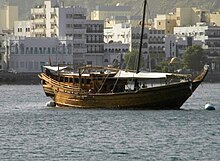
Outwardly, Oman shares many of the cultural characteristics of its Arab neighbours, particularly those in theGulf Cooperation Council.[250]Despite these similarities, important factors make Oman unique in the Middle East.[250]These result as much from geography and history as from culture and economics.[250]The relatively recent and artificial nature of thestatein Oman makes it difficult to describe a national culture;[250]however, sufficient cultural heterogeneity exists within its national boundaries to make Oman distinct from other Arab States of the Persian Gulf.[250]Oman's cultural diversity is greater than that of its Arab neighbours, given its historical expansion to the Swahili Coast and the Indian Ocean.[250]
Oman has a long tradition of shipbuilding, as maritime travel played a major role in the Omanis' ability to stay in contact with the civilisations of the ancient world.Surwas one of the most famous shipbuilding cities of the Indian Ocean. Anal Ghanjaship takes one whole year to build. Other types of Omani ship include As Sunbouq and Al Badan.[251]
Dress
[edit]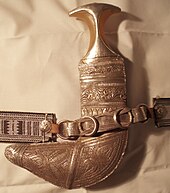
The malenational dressin Oman consists of thedishdasha,a simple, ankle-length, collarless gown with long sleeves.[252]Most frequently white in colour, the dishdasha may also appear in a variety of other colours. Its main adornment, atassel(furakha) sewn into the neckline, can be impregnated with perfume.[253]Underneath the dishdasha, men wear a plain, wide strip of cloth wrapped around the body from the waist down. The most noted regional differences in dishdasha designs are the style with which they are embroidered, which varies according to age group.[252]On formal occasions a black or beige cloak called abishtmay cover the dishdasha. The embroidery edging the cloak is often in silver or gold thread and it is intricate in detail.[253]
Omani men wear two types of headdress:
- theghutra,also called "Musar" a square piece of woven wool or cotton fabric of a single colour, decorated with various embroidered patterns.
- thekummah,a cap that is the head dress worn during leisure hours.[252]
Some men carry theassa,a stick, which can have practical uses or is simply used as an accessory during formal events. Omani men, on the whole, wear sandals on their feet.[253]
TheJanbiya(dagger) forms part of the national dress and men wear the Janbiya on all formal public occasions and festivals.[252]It is traditionally worn at the waist. Sheaths may vary from simple covers to ornate silver or gold-decorated pieces.[253]A depiction of a Janbiya appears on the national flag.[252]
Omani women wear eye-catching national costumes, with distinctive regional variations. All costumes incorporate vivid colours and vibrant embroidery and decorations. The Omani women's traditional costume comprises several garments: thekandoorah,which is a long tunic whose sleeves orradoonare adorned with hand-stitched embroidery of various designs. Thedishdashais worn over a pair of loose-fitting trousers, tight at the ankles, known as asirwal.Women also wear a head shawl most commonly referred to as thelihaf.[254]
As of 2014[update]women reserve wearing their traditional dress for special occasions, and instead wear a loose black cloak called anabayaover their personal choice of clothing, whilst in some regions, particularly amongst the Bedouin, theburqais still worn.[254]Women wearhijab,and though some women cover their faces and hands, most do not. The Sultan has forbidden the covering of faces in public office.[249]
Music and cinema
[edit]Music of Omanis extremely diverse due to Oman's imperial legacy. There are over 130 different forms of traditional Omani songs and dances. The Oman Centre for Traditional Music was established in 1984 to preserve them.[255]In 1985, Sultan Qaboos founded the Royal Oman Symphony Orchestra. Instead of engaging foreign musicians, he decided to establish an orchestra made up of Omanis.[256]On 1 July 1987 at the Al Bustan Palace Hotel's Oman Auditorium the Royal Oman Symphony Orchestra gave its inaugural concert.[257]In popular music, a seven-minute music video about Oman went viral, achieving 500,000 views on YouTube within 10 days of being released on YouTube in November 2015. The a cappella production features three of the region's most popular talents: Kahliji musician Al Wasmi, Omani poet Mazin Al-Haddabi and actress Buthaina Al Raisi.[258]

Thecinema of Omanis very small, there being only one Omani filmAl-Boom(2006) as of 2007[update].Oman Arab Cinema Company LLC is the single largest motion picture exhibitor chain in Oman.[259]
Media
[edit]The government has continuously held a monopoly on television in Oman.Oman TVis the only state-owned national television channel broadcaster in Oman. Oman TV broadcasts four HD channels, including Oman TV General, Oman TV Sport, Oman TV Live and Oman TV Cultural.[260]Although private ownership of radio and television stations is permitted, Oman has only one privately owned television channel.[261]Majan TV is the first private TV channel in Oman. It began broadcasting in January 2009. However, Majan TV's official channel website was last updated in early 2010.[262]The public has access to foreign broadcasts since the use of satellite receivers is allowed.[261][263]
Oman Radio is the first and only state-owned radio channel.[261]It began broadcasting on 30 July 1970.[264]It operates both Arabic and English networks. Other private channels include Hala FM, Hi FM, Al-Wisal, Virgin Radio Oman FM and Merge. In early 2018, Muscat Media Group (MMG) launched a new private radio station.[265][266][267]
Oman has nine main newspapers, five in Arabic and four in English.[268]
The media landscape in Oman has been continuously described as restrictive, censored, and subdued.[269]The Ministry of Information censors politically, culturally, or sexually offensive material in domestic or foreign media. The press freedom groupReporters Without Bordersranked the country 127th out of 180 countries on its 2018 World Press Freedom Index. In 2016, the government drew international criticism for suspending the newspaperAzamnand arresting three journalists after a report on corruption in the country's judiciary.Azamnwas not allowed to reopen in 2017 although an appeal court ruled in late 2016 that the paper can resume operating.[270]
Art
[edit]Traditional art in Oman stems from its long heritage of material culture. Art movements in the 20th century reveal that the art scene in Oman began with early practices that included a range of tribal handicrafts and self-portraiture in painting since the 1960s.[271]However, since the inclusion of several Omani artists in international collections, art exhibitions, and events, such Alia Al Farsi, the first Omani artist to show at the lastVenice Biennaleand Radhika Khimji, the first Omani artist to exhibit at both theMarrakeshandHaiti Ghetto biennale,Oman's position as a newcomer to the contemporary art scene in recent years has been more important for Oman's international exposure.[272]

Bait Muzna Gallery is the first art gallery in Oman. Established in 2000 by Sayyida Susan Al Said, Bait Muzna has served as a platform for emerging Omani artists to showcase their talent and place themselves on the wider art scene. In 2016, Bait Muzna opened a second space inSalalahto branch out and supportart filmand thedigital artscene. The gallery has been primarily active as an art consultancy.[272][274]The Omani Society for Fine Arts, established in 1993, offers educational programmes, workshops and artist grants for practitioners across varied disciplines.[272]
The Sultanate's flagship cultural institution, theNational Museum of Oman,opened on 30 July 2016 with 14 permanent galleries. It showcases national heritage from the earliest human settlement in Oman two million years ago through to the present day. The museum takes a further step by presenting information on the material inArabic Braillescript for the visually impaired, the first museum to do this in the Gulf region.[272]Bait Al Zubair Museumis a private, family-funded museum that opened its doors to the public in 1998. In 1999, the museum receivedSultan Qaboos' Award for Architectural Excellence. Bait Al Zubair displays the family's collection of Omani artifacts.[275]
Omani cuisine
[edit]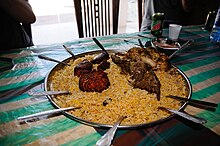
Omani cuisine is diverse and has been influenced by many cultures. Omanis usually eat their main daily meal at midday, while the evening meal is lighter. DuringRamadan,dinner is typically served after theTaraweehprayers, sometimes as late as 11 pm.
Arsia, a festival meal served during celebrations, consists of mashed rice and meat (sometimes chicken). Another popular festival meal, shuwa, consists of meat cooked very slowly (sometimes for up to 2 days) in an underground clay oven. Fish is often used in main dishes too, and thekingfishis a popular ingredient. Mashuai is a meal consisting of a whole spit-roasted kingfish served with lemon rice. Rukhal bread is a thin, round bread eaten at any meal, typically served with Omani honey for breakfast or crumbled over curry for dinner. The Omanihalwais a very popular sweet, consisting of cooked raw sugar with nuts. There are many different flavors, the most popular ones being black halwa (original) and saffron halwa. Halwa is considered a symbol of Omani hospitality, traditionally served with coffee. As is the case with mostArab states of the Persian Gulf,alcohol is only available over the counter to non-Muslims.
Sports
[edit]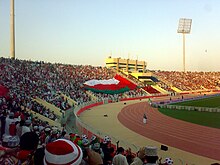
In October 2004, the Omani government set up a Ministry of Sports Affairs to replace the General Organisation for Youth, Sports and Cultural Affairs. The19th Arabian Gulf Cuptook place inMuscat,from 4 to 17 January 2009 and was won by theOmani national football team.The23rd Arabian Gulf Cupthat took place inKuwait,from 22 December 2017 until 5 January 2018 with Oman winning their second title, defeating theUnited Arab Emiratesin the final.
Oman's traditional sports aredhowracing,horse racing,camel racing,bull fightingandfalconry.[276]Association football,basketball,waterskiingandsandboarding[277]are among the sports that have emerged quickly and gained popularity among the younger generation.[276]Oman, along withFujairahin theUAE,are the only regions in the Middle East that have a variant ofbullfighting,known as 'bull-butting', organised within their territories.[278]Al-Batena area in Oman is specifically prominent for such events.

TheOman Olympic Committeeplayed a major part in organising the highly successful 2003 Olympic Days, which were of great benefit to the sports associations, clubs, and young participants. Thefootballassociation took part, along with thehandball,basketball,rugby union,field hockey,volleyball,athletics,swimming andtennisassociations. In 2010 Muscat hosted the2010 Asian Beach Games.Oman featured a men's national team inbeach volleyballthat competed at the2018–2020 AVC Beach Volleyball Continental Cup.[279]
Oman also hosts tennis tournaments each year. TheSultan Qaboos Sports Complexstadium contains a 50-meter swimming pool that is used for international tournaments. The Tour of Oman, a professional cycling 6-day stage race, takes place in February. Oman hosted the Asian2011 FIFA Beach Soccer World Cup qualifiers,where 11 teams competed for three spots at theFIFA World Cup.Oman hosted the Men's and Women's2012 Beach Handball World Championshipsat the Millennium Resort in Mussanah, from 8 to 13 July.[280]The first "El Clasico"to be played outside of Spain, was played on 14 March 2014, at theSultan Qaboos Sports Complex.[281]
Oman has competed repeatedly for a position in theFIFA World Cup,but have not yet qualified to compete in the tournament. Incricket,Oman qualified for the2016 ICC World Twenty20and the 2021 T20 Cricket World Cup. On 25 June 2021, it was confirmed that Oman will co-host the2021edition of theICC Men's T20 World Cupalongside the United Arab Emirates.[282]In 2024, Oman participated in the2024 Touch Rugby World CupinNottingham,which was its first participation in an international rugby tournament.[283]
Gallery
[edit]- Muscat, Oman
-
A mosque inMuscat,Oman
-
Mutrah Fort,Muscat,Oman
-
Al Ameen Mosque,Muscat,Oman
-
Sultan Qaboos Grand Mosque,Muscat,Oman
-
Sultan's Ship, Mutrah,Muscat,Oman
-
Al Amarat Hills,Muscat,Oman
-
Al Azaiba Beach,Muscat,Oman
-
Library ofSultan Qaboos Grand Mosque,Muscat,Oman
See also
[edit]Notes
[edit]- ^In 1783, when Seyyid Said succeeded to the "masnad" of Muscat and Oman (an independent state founded in 1749), he fell out with his brother Imam Sultan, who fled to safety in Makran and entered into communication with Nasir Khan of Kalat. Said was granted the Kalat share of the revenues of Gwadar and lived there until 1797 when he came to rule over Muscat and Oman.
- ^Gwadar remained an Omani possession as part of the Sultanate until September 1958
References
[edit]- ^"Basic Statute of the State promulgated by Royal Decree 101/96".MINISTRY OF JUSTICE AND LEGAL AFFAIRS.Archived fromthe originalon 7 July 2020.Retrieved31 August2020.
- ^"National Profiles".
- ^Oman.MSN Encarta. Archived fromthe originalon 28 October 2009.Retrieved20 November2008.
In 751 Ibadi Muslims, established an imamate in Oman. Despite interruptions, the Ibadi imamate survived until the mid-20th century.
- ^"Oman".Carnegie Endowment for International Peace. 15 July 2010.Retrieved31 December2021.
- ^ab"World Population Prospects 2022".United Nations Department of Economic and Social Affairs,Population Division.Retrieved17 July2022.
- ^ab"World Population Prospects 2022: Demographic indicators by region, subregion and country, annually for 1950-2100"(XSLX)( "Total Population, as of 1 July (thousands)" ).United Nations Department of Economic and Social Affairs,Population Division.Retrieved17 July2022.
- ^"Final Results of Census 2010"(PDF).National Center for Statistics & Information. Archived fromthe original(PDF)on 18 May 2013.Retrieved7 January2012.
- ^abcd"World Economic Outlook Database, October 2023 Edition. (Oman)".IMF.org.International Monetary Fund.10 October 2023.Retrieved13 October2023.
- ^"Urban – Gini index – Omani – Total".The National Centre for Statistics and Information, Sultanate of Oman.Archivedfrom the original on 21 May 2018.Retrieved20 May2018.
- ^"Human Development Report 2023/24"(PDF).United Nations Development Programme.13 March 2024.Archived(PDF)from the original on 13 March 2024.Retrieved13 March2024.
- ^"Oman Population (2024)".Worldometer.Archivedfrom the original on 10 June 2020.Retrieved22 August2024.
- ^abKharusi, N. S. (2012). "The ethnic label Zinjibari: Politics and language choice implications among Swahili speakers in Oman".Ethnicities.12(3): 335–353.doi:10.1177/1468796811432681.ISSN1468-7968.S2CID145808915.
- ^abcdefghijk"Country Report: Oman".BTI Project. 2016. Archived fromthe originalon 12 March 2020.Retrieved19 August2016.
- ^"Haitham bin Tariq sworn in as Oman's new sultan".Al Jazeera. 12 January 2020. Archived fromthe originalon 11 January 2020.Retrieved12 January2020.
- ^abc"Oman profile – Overview".BBC News. 11 September 2012. Archived fromthe originalon 12 March 2020.Retrieved18 January2013.
- ^Royal Air Force Museum,A History of Oman.Retrieved 19 November 2020
- ^"Private sector gets Omanisation targets".Gulf News.13 February 2011. Archived fromthe originalon 9 October 2019.Retrieved18 January2013.
- ^"Five Arab states among top leaders in long-term development gains".Hdr.undp.org. 4 November 2010. Archived fromthe originalon 9 November 2013.Retrieved29 October2011.
- ^"Global Peace Index: 2021"(PDF).visionofhumanity.org.Global Peace IndexandInstitute for Economics and Peace.p. 9.Archived(PDF)from the original on 24 March 2022.Retrieved6 April2022.
- ^"Pre-Islamic – SAA".saa.shj.ae.Archivedfrom the original on 8 October 2023.Retrieved6 October2023.
- ^Pliny the Elder.Natural History,VI.149.
- ^Ptolemy, Claudius.Geography.VI.7.36.
- ^abBrill, E. J. (1987) [1913].E.J. Brill's First Encyclopaedia of Islam 1913-1936.Leiden: BRILL.ISBN978-90-04-08265-6.
- ^Tarikh fi Uman[Oman in History].
- ^Rose, J. I.; Usik, V. I.; Marks, A. E.; Hilbert, Y. H.; Galletti, C. S.; Parton, A.; Geiling, J. M.; Černý, V.; Morley, M. W.; Roberts, R. G. (2011)."The Nubian Complex of Dhofar, Oman: An African Middle Stone Age Industry in Southern Arabia".PLOS ONE.6(11): e28239.Bibcode:2011PLoSO...628239R.doi:10.1371/journal.pone.0028239.PMC3227647.PMID22140561.
- ^Jeffrey I. Rose et al., South Punjab, Oman: An African Middle Stone Age Industry in Southern Arabia, Plos 30 November 2011doi:10.1371/journal.pone.0028239
- ^Thornton, Christopher; Cable, Charlotte; Possehl, Gregory (2016).The Bronze Age Towers at Bat, Sultanate of Oman…2007–12.University of Pennsylvania Museum.ISBN9781934536063.
- ^abBritish National Archive: Salîl-ibn-Razîk "History of the imâms and seyyids of Omân"Archived7 July 2022 at theWayback MachineHistory of the imâms and seyyids of Omân. British National Archive page 39 QDL
- ^abcdeSalîl-ibn-Razîk.British National Archive: History of the imâms and seyyids of Omân(54/612).Archived8 July 2022 at theWayback MachineHistory of the imâms and seyyids of Omân. British National Archive. Page 54. QDL.
- ^Wilkinson, John (1977).Water and Tribal Settlement in South East Arabia – A Study of the Aflaj of Oman.Clarendon Press. pp. 76, 85, 122, 126–130, 132.ISBN0198232179.
- ^Yule, Paul (2014).Cross-roads Early and Late Iron Age South-Eastern Arabia.Harrassowitz Verlag. pp. 15–18.ISBN9783447101271.
- ^"Digging in the Land of Magan – Archaeology Magazine Archive".Archive.archaeology.org.Archivedfrom the original on 23 October 2013.Retrieved14 January2014.
- ^"Oman: The Lost Land".Saudi Aramco World.March 1983. Archived fromthe originalon 6 October 2014.Retrieved14 January2014.
- ^"Oman: A History".Saudi Aramco World.March 1983. Archived fromthe originalon 28 December 2014.Retrieved14 January2014.
- ^Feuerstein, Georg; Kak, Subhash; Frawley, David (2005).The Search of the Cradle of Civilization: New Light on Ancient India.Motilal Banarsidass Publisher. p. 119.ISBN8120820371.
- ^Gerd Weisgerber "Mehr als Kupfer in Oman"Anschnitt5-6, 1981, 180–181Archaeology of Oman
- ^abcSalîl-ibn-Razîk.British National Archive: History of the imâms and seyyids of Omân (40/612)Archived7 July 2022 at theWayback MachineHistory of the imâms and seyyids of Omân. British National Archive. QDL.
- ^Annals of 'Omān.British National Archive: Annals of 'Omān' [3] (20/112).Archived8 March 2021 at theWayback MachineBritish National Archive. Page 20. QDL.
- ^abUlrich, Brian (2008). "The Azd migrations reconsidered: narratives of ʿAmr Muzayqiya and Mālik b. Fahm in historiographic context by Brian Ulrich (21 July 2007)".Proceedings of the Seminar for Arabian Studies.38.JSTOR: 311–318.JSTOR41223958.
- ^Maisel & Shoup 2009,p. 193.
- ^Robert Geran Landen (8 December 2015).Oman Since 1856 (1967).Princeton Legacy Library.ISBN9781400878277.Archivedfrom the original on 11 February 2023.Retrieved8 May2020.
- ^Hopwood, Derek (2016).The Arabian Peninsula: Society and Politics.Routledge.
- ^Hawley, Donald (1984).Oman and Its Renaissance.Humanities Press. p. 18.
- ^"History of OMAN".Historyworld.net.Archivedfrom the original on 2 August 2009.Retrieved17 April2010.
- ^"Oman".United States Department of State.31 March 2010.Archivedfrom the original on 17 August 2021.Retrieved9 July2010.
Oman adoptedIslamin the seventh century A.D., during the lifetime of Muhammad.
- ^Salîl-ibn-Razîk.British National Archive: History of the imâms and seyyids of 'Omân (44/612).Archived7 July 2022 at theWayback MachineHistory of the imâms and seyyids of 'Omân. British National Archive. Page 44. QDL.
- ^abcdefgMajid Alkhalili.Majid Alkhalili:Oman's Foreign Policy.Archived13 April 2023 at theWayback MachineOman's Foreign Policy: Foundation and Practice. 19 May 2009. Praeger.
- ^Salîl-ibn-Razîk.British National Archive: History of the imâms and seyyids of 'Omân (164/612).Archived7 July 2022 at theWayback MachineHistory of the imâms and seyyids of 'Omân. British National Archive. Page 164. QDL.
- ^Salîl-ibn-Razîk.British National Archive: History of the imâms and seyyids of 'Omân (165/612).Archived8 March 2021 at theWayback MachineHistory of the imâms and seyyids of 'Omân. British National Archive. Page 165. QDL.
- ^Salîl-ibn-Razîk.British National Archive: History of the imâms and seyyids of 'Omân (166/612).Archived7 July 2022 at theWayback MachineHistory of the imâms and seyyids of 'Omân. British National Archive. Page 166. QDL.
- ^Hans kruse.Notes and Memoranda of OmanHans kruse.Archived10 July 2022 at theWayback MachineDisturbances in Oman: Notes and Memoranda of Oman. Sage Journals. 1 October 1965.
- ^abSalîl-ibn-Razîk.British National Archive: History of the imâms and seyyids of 'Omân (46/612).Archived9 July 2022 at theWayback MachineHistory of the imâms and seyyids of 'Omân. British National Archive. Page 46. QDL.
- ^Salîl-ibn-Razîk.British National Archive: History of the imâms and seyyids of 'Omân by Salîl-ibn-Razîk, from A.D. 661–1856 (168/612)Archived7 July 2022 at theWayback MachineHistory of the imâms and seyyids of 'Omân. British National Archive. Page 168. QDL.
- ^abcdeJ. C. Wilkinson.The Oman Question: The Background to the Political Geography of South-East Arabia.Archived16 June 2022 at theWayback MachineThe Oman Question: The Background to the Political Geography of South-East Arabia. Pages 361–371. The Geographical Journal. JSTOR. 1971.
- ^abUzi Rabi.Emergence of States in a Tribal Society: Oman Under Sa'Id Bin Taymur.Emergence of States in a Tribal Society: Oman Under Sa'Id Bin Taymur.
- ^Rabi, Uzi (11 March 2011).Emergence of States in a Tribal Society: Oman Under Sa'Id Bin Taymur, 1932–1970.Apollo Books.ISBN9781845194734– via Google Books.
- ^Nabhan, Gary Paul (11 March 2008).Arab/American: Landscape, Culture, and Cuisine in Two Great Deserts.University of Arizona Press.ISBN9780816526581– via Google Books.
- ^Salîl-ibn-Razîk.British National Archive: History of the imâms and seyyids of Omân(202/612).Archived8 March 2021 at theWayback MachineHistory of the imâms and seyyids of Omân. British National Archive. Page 202. QDL.
- ^Gavin Thomas.The Rough Guide to Oman.Archived11 February 2023 at theWayback MachineThe Rough Guide to Oman.
- ^Holt, Peter Malcolm; Lambton, Ann K. S. and Lewis, Bernard (1977)The Cambridge history of IslamCambridge University PressISBN0521291364.
- ^Willem Floor, "Dutch Relations with the Persian Gulf", in Lawrence G. Potter (ed.),The Persian Gulf in History(Palgrave Macmillan, 2009) p. 240
- ^abOman Country Profile.Oman Country Profile.Archived20 July 2019 at theWayback MachineBritish Library Partnership. Qatar Digital Library. 2014.
- ^"'History of the imâms and seyyids of 'Omân by Salîl-ibn-Razîk, from A.D. 661–1856; translated from the original Arabic, and edited with notes, appendices, and an introduction, continuing the history down to 1870, by George Percy Badger, F.R.G.S., late chaplain in the Presidency of Bombay.' [23] (56/612) ".Qatar Digital Library.22 October 2014.Archivedfrom the original on 7 July 2022.Retrieved6 September2019.
- ^Stefan Siebert.The Rough Guide to Oman.Archived11 February 2023 at theWayback MachineThe Rough Guide to Oman. 2011.
- ^Salîl-ibn-Razîk.History of the imâms and seyyids of 'Omân by Salîl-ibn-Razîk, from A.D. 661–1856 (83/612)British National Archive.Archived10 March 2021 at theWayback MachineHistory of the imâms and seyyids of 'Omân. British National Archive. Page 83. QDL.
- ^Salîl-ibn-Razîk.History of the imâms and seyyids of 'Omân by Salîl-ibn-Razîk, from A.D. 661–1856 (86/612).Archived7 July 2022 at theWayback MachineHistory of the imâms and seyyids of 'Omân. British National Archive. Page 86. QDL.
- ^Salîl-ibn-Razîk.History of the imâms and seyyids of 'Omân by Salîl-ibn-Razîk, from A.D. 661–1856 (92/612)British National Archive.Archived7 July 2022 at theWayback MachineHistory of the imâms and seyyids of 'Omân. British National Archive. Page 92. QDL.
- ^abRobert Geran Landen.Oman Since 1856: Disruptive Modernization in a Traditional Arab Society.Archived10 July 2022 at theWayback MachineOman Since 1856: Disruptive Modernization in a Traditional Arab Society. Journal of the American Oriental Society. Pages 581–583. JSTOR. 1970. Vol. 90, No. 4.
- ^Cowasjee, Ardeshir (11 September 2005)."DAWN – Cowasjee Corner; September 11, 2005".DAWN Group of Newspapers. Archived fromthe originalon 9 June 2010.Retrieved27 July2010.
- ^abcdDr Francis Owtram (11 December 2014)."A Close Relationship: Britain and Oman Since 1750".QDL.Archivedfrom the original on 8 March 2021.Retrieved27 July2019.2014.
- ^[Joseph A. Kechichian "Oman and the World: The Emergence of an Independent Foreign Policy" RAND 1995]
- ^abSalîl-ibn-Razîk.History of the imâms and seyyids of 'Omân by Salîl-ibn-Razîk, from A.D. 661–1856 (89/612)Archived8 March 2021 at theWayback MachineHistory of the imâms and seyyids of 'Omân. British National Archive. Page 89. QDL.
- ^Muscat and the Monsoon.British National Archive: Muscat and the MonsoonArchived8 March 2021 at theWayback MachineBritish National Archive. QDL.
- ^A Collection of Treaties and Engagements.British National Archives:A Collection of Treaties and Engagements relating to the Persian Gulf Shaikhdoms and the Sultanate of Muscat and Oman in force up to the End of 1953' [26v] (54/92).Archived6 July 2022 at theWayback MachineBritish National Archives. Page 54. QDL.
- ^Historical Summary of Events.British National Archive: Historical Summary of Events 189/222Archived8 March 2021 at theWayback MachineBritish National Archive. Page 189. QDL.
- ^Muscat and Oman Internal Affairs History.British National Archive: Muscat and Oman Internal Affairs HistoryArchived8 March 2021 at theWayback MachineBritish National Archive. Page 191. QDL.
- ^abcdeIan Cobain.The Guardian: Britain's secret warsArchived30 September 2016 at theWayback MachineBritain's Secret Wars.The Guardian.8 September 2016.
- ^The Financial Troubles of Said bin Taimur.British National Archive: The Financial Troubles of Said bin TaimurArchived11 November 2020 at theWayback MachineBritish National Archive. QDL.
- ^ab2302 Question of Oman.United Nations:2302 Question of Oman.Archived26 October 2021 at theWayback MachineUnited Nations. 12 December 1967.
- ^E. C. B. MacLaurin "Oman and the Trucial Coast"Archived17 January 2023 at theWayback MachineOman and the Trucial Coast. Pages 65–76. The Australian Quarterly. JSTOR. 1958.
- ^Muscat State Affairs.British National Archive: File 8/67 Muscat State Affairs: Muscat– Oman TreatyArchived8 July 2022 at theWayback MachineBritish National Archive. File 8/67. Page 20. QDL.
- ^abc"Jebel Akhdar".Britain's Small Wars. Archived fromthe originalon 17 September 2013.Retrieved10 April2012.
- ^Muscat Rising.British National Archive: Muscat Rising, from April 1917 to January 1918 & resumed from April 1920 to Oct 1920Archived7 July 2022 at theWayback MachineBritish National Archive QDL
- ^abOman profile – Timeline."BBC Middle East: Oman profile – Timeline (25 April 2018)".BBC News. 25 April 2018.Archivedfrom the original on 11 June 2022.Retrieved2 August2019.25 April 2018.
- ^Undertaking by Sultan Taimur Regarding Oil.Undertaking by Sultan Taimur Regarding Oil.Archived9 March 2021 at theWayback MachineBritish National Archives page 60 QDL
- ^The 1928 Red Line Agreement.United States Office of the Historian: The 1928 Red Line AgreementArchived17 July 2019 at theWayback MachineUnited States Office of the Historian.
- ^Muscat Rising.British National Archive: Muscat Rising, from April 1917 to January 1918 & resumed from April 1920 to Oct 1920Archived25 February 2021 at theWayback MachineBritish National Archive page 190 QDL
- ^abcMark Curtis.British National Archives.Archived3 March 2021 at theWayback MachineOman 1957-9. British National Archives. 2017.
- ^Fred Halliday.Arabia by Fred HallidayArchived6 April 2023 at theWayback MachineArabia. The Arabian Peninsula. Saqi Books. University of California. published 1974.
- ^abPeterson, J. E. (2 January 2013).Oman's Insurgencies: The Sultanate's Struggle for Supremacy.Saqi.ISBN9780863567025.Archivedfrom the original on 11 February 2023.Retrieved29 April2018– via Google Books.
- ^Historical Summary of Events in the Persian Gulf."British National Archive: Historical Summary of Events in the Persian Gulf (208/222)".QDL. 30 May 2014. Archived fromthe originalon 23 July 2019.British National Archive. Page 208.
- ^"Oman".NevingtonWarMuseum.com.Retrieved9 August2024.
- ^"The Second World War".Royal Air Force Museum.Retrieved9 August2024.
- ^"German WW2 u-boat located off Oman".X-Ray Mag.16 September 2011.Retrieved9 August2024.
- ^Baldwin, Derek (17 December 2009)."What lies beneath: Nazi wreck off Fujairah".Gulf News.Retrieved9 August2024.
- ^Nicolin, Beatrice (25 May 1998)."International trade networks: The Omani Enclave of Gwadar – Conference on German and International Research on Oman, Bonn 1998: abstracts".Bonn: Conference on German and International Research on Oman. Archived fromthe originalon 4 January 2020.Retrieved27 July2010.
- ^Muscat State Affairs.A.C.Gallowey:File 8/62 Muscat State Affairs: Principal Shaikhs and Tribes of Oman' [35r] (69/296).Archived8 March 2021 at theWayback MachinePrincipal Shaikhs and Tribes of Oman. British National Archive. Page 69. QDL.
- ^Muscat State Affairs.British Consulate Muscat: File 8/62 Muscat State Affairs: Principal Shaikhs and Tribes of Oman.Archived8 March 2021 at theWayback MachineBritish National Archive. File 8/62. Page 153. 25 May 1946. QDL.
- ^Muscat State Affairs.The Foreign Office London: File 8/62 Muscat State Affairs: Principal Shaikhs and Tribes of Oman [146r] (291/296).Archived8 March 2021 at theWayback MachineBritish National Archive. Page 291. QDL.
- ^Peterson, John E. (1978).Oman in the Twentieth Century: Political Foundations of an Emerging State.Croom Helm. p. 182.ISBN9780856646294.
- ^Liquid Oman: oil, water, and causality in Southern Arabia.Liquid Oman: oil, water, and causality in Southern ArabiaArchived17 January 2023 at theWayback MachineRoyal Anthropological Institute. P. 147–162. 2016. City University of New York.
- ^abRyan, Mike (2003).Secret Operations of the Sas.Zenith Imprint. pp. 68–70.ISBN9780760314142.[permanent dead link]
- ^abcOwtram, Francis (2004).A Modern History of Oman: Formation of the State since 1920.I.B.Tauris. p. 106.ISBN9781860646171.
- ^The Last Imam of Oman.CNN Arabic: وفاة آخر أئمة عُمان في منفاه السياسي بالسعوديةArchived11 April 2022 at theWayback MachineCNN Arabic News. 1 December 2009. Muscat, Oman.
- ^10 Arab States Ask U.N. Debate On Oman.The New York Times. 01 October 1960.Archived17 January 2023 at theWayback MachineThe New York Times.
- ^Question of Oman.United Nations Archives.Archived18 August 2021 at theWayback MachineUnited Nations Archives.
- ^20th Session Adopted Resolutions.United Nations:20th Session Adopted Resolutions.Archived17 May 2022 at theWayback MachineUnited Nations. 20 September – 20 December 1965.
- ^2073 Question of Oman.United Nations:2073 Question of Oman.Archived8 March 2021 at theWayback MachineUnited Nations. 17 December 1965.
- ^22nd Session Adopted Resolutions.United Nations:22nd Session Adopted Resolutions.Archived17 May 2022 at theWayback MachineUnited Nations. 19 September – 19 December 1967.
- ^UN General Assembly."UN 2238 Question of Oman Resolution (1966)"(PDF).worldlii.Archived(PDF)from the original on 7 March 2021.Retrieved27 August2019.
- ^UN General Assembly."UN Adopted Resolutions (1966)".worldlii.Archivedfrom the original on 25 April 2022.Retrieved27 August2019.
- ^"Happy and rich in an Omani toytown".The Economist.31 August 2000. Archived fromthe originalon 21 November 2018.
- ^الفالح, عبدالعزيز بن عبدالله (2021).كنت طالبا في عمان(in Arabic). دار الثلوثية.ISBN9786030362981.
- ^"بعد 38 عاماً.. طلاب من سلطنة عمان يزورون معلمهم في السعودية".www.al-jazirah.com.Archivedfrom the original on 3 January 2024.Retrieved16 September2023.
- ^Benjamin Plackett (30 March 2017)."Omani Music Masks A Slave Trading Past".Al-Fanar Media.Archivedfrom the original on 17 January 2023.Retrieved17 July2017.
- ^"Oman appoints first female minister".BBC News.4 March 2003. Archived fromthe originalon 17 September 2019.
- ^"Oman profile – Timeline".BBC News.11 September 2012. Archived fromthe originalon 10 May 2019.Retrieved18 January2013.
- ^"Sultan Qaboos of Oman dies aged 79".BBC News.11 January 2020. Archived fromthe originalon 5 April 2020.Retrieved10 January2020.
- ^"Haitham bin Tariq appointed new ruler of Oman".Arab News.11 January 2020. Archived fromthe originalon 13 January 2020.
- ^"Oman Geography 2007".home.kpn.nl.Archived fromthe originalon 25 September 2018.Retrieved11 July2016.
- ^"Expedition Report: Dhofar Mountains Oman".30 April 2011. Archived fromthe originalon 10 October 2017.Retrieved11 July2016.
- ^abKrogh, Jan S."Oman".jankrogh.com. Archived fromthe originalon 4 May 2019.
- ^"Nahwa – United Arab Emirates".geosite.jankrogh.com.Archived fromthe originalon 9 May 2019.
- ^4th Swiss Geoscience Meeting, Bern 2006. Meteorite accumulation surfaces in Oman: Main results of. Omani-Swiss meteorite search campaigns, 2001–2006. by Beda Hofmann et al.
- ^"Muscat (Seeb) Climate Oman".www.world-climates.com. Archived fromthe originalon 7 April 2014.Retrieved11 July2016.
- ^"Oman—Country Pasture/Forage Resource Profiles".Food and Agriculture Organization. Archived fromthe originalon 25 June 2016.Retrieved28 January2013.
- ^"Salalah Climate – Climate of Salalah Oman".world-climates.com. Archived fromthe originalon 9 August 2017.Retrieved11 July2016.
- ^"Weather—Oman".BBC.Archivedfrom the original on 24 January 2013.Retrieved21 January2013.
- ^Snow blankets Oman's mountains as temperatures dropArchived13 April 2014 at theWayback Machine.Gulf News(16 February 2014). Retrieved 20 April 2014.
- ^Philip's encyclopedia.Philip's. 2008.
- ^"Quriyat in Oman breaks world temperature record".CNN. 2018.Archivedfrom the original on 3 July 2018.Retrieved29 July2018.
- ^abcSustainable Development Report Dashboards 2019 Oman.Sustainable Development Report Dashboards 2019 OmanSDG Index. 2019.
- ^"BirdLife Data Zone".datazone.birdlife.org.Archivedfrom the original on 9 October 2022.Retrieved11 August2021.
- ^"UNESCO World Heritage Center – Oman's Arabian Oryx Sanctuary: first site ever to be deleted from UNESCO's World Heritage List".UNESCO.Archivedfrom the original on 5 July 2020.Retrieved17 April2010.
- ^Animal TragedyArchived29 May 2016 at theWayback Machine.y-oman.com. 27 June 2013.
- ^Macdonald, Sarah (22 March 2014)Strays on streets a growing issue for OmanArchived12 January 2015 at theWayback Machine.Times of Oman
- ^Captive CreaturesArchived30 June 2016 at theWayback Machine.y-oman.com. 21 November 2013
- ^Ettinger, Powell."Whales and dolphins of Oman – Dolphins, Humpbacks and Blue whales!".Archivedfrom the original on 29 July 2016.Retrieved21 January2016.
- ^"Q&A: Elections to Oman's Consultative Council".BBC News.Archivedfrom the original on 28 January 2020.Retrieved21 July2018.
- ^"Oman".Freedom House.Archivedfrom the original on 23 April 2019.Retrieved18 January2013.
- ^"OMAN Majles A'Shura (Consultative Council)".Inter-Parliamentary Union.Archivedfrom the original on 27 February 2013.Retrieved19 January2013.
- ^"Oman".Freedom in the World 2012.Freedom House. 17 January 2012.Archivedfrom the original on 25 October 2012.Retrieved28 January2013.
- ^ab"Waking up too".The Economist.23 June 2012.Archivedfrom the original on 28 December 2017.Retrieved19 January2013.
- ^Stork, Joe (19 December 2012)."Human rights in the smaller Persian Gulf states: Bahrain, Kuwait, Oman, Qatar and UAE".NOREF.Archived fromthe originalon 8 March 2014.Retrieved18 January2013.
- ^"Basic Statute of the State"(PDF).Royal Decree 101/96.Ministry of Legal Affairs.Archived fromthe original(PDF)on 23 July 2013.Retrieved18 August2012.
- ^"Amendment to Some of the Provisions of the Basic Statute of the State"(PDF).Royal Decree 99/2011.Ministry of Legal Affairs. Archived fromthe original(PDF)on 17 January 2013.
- ^ab"Country Profiles (Legislature) – Oman".Arab Parliaments. Archived fromthe originalon 5 June 2012.
- ^ab"Legislative Branch".The World Factbook.Archived fromthe originalon 13 June 2007.Retrieved19 January2013.
- ^abcde"Oman".CIA – The World Factbook.Archivedfrom the original on 13 March 2021.Retrieved29 October2011.
- ^Kechichian, Joseph A. (1995)."Oman: A Unique Foreign Policy".RAND.Archivedfrom the original on 4 March 2016.Retrieved29 October2011.
- ^Roy, Shubhajit (13 February 2018)."India gets access to strategic Oman port Duqm for military use, Chabahar-Gwadar in sight".The Indian Express.Archivedfrom the original on 10 April 2019.Retrieved24 March2019.
- ^According to SIPRIArchived2 May 2019 at theWayback Machine|Excel SpreadsheetArchived24 February 2022 at theWayback Machine
- ^Oman's Military Expenditures.Oman's military expenditures WBArchived18 January 2023 at theWayback MachineThe World Bank. Retrieved 2019.
- ^abcdAnthony H. Cordesman; Khalid R. Al-Rodhan (28 June 2006)."The Gulf Military Forces in an Era of Asymmetric War"(PDF).Center for Strategic and International Studies. Archived fromthe original(PDF)on 17 May 2013.Retrieved19 January2013.
- ^"Testing times for corvette".Maritime Photographic. 15 March 2012. Archived fromthe originalon 13 October 2014.Retrieved21 January2013.
- ^"The SIPRI Military Expenditure Database".Stockholm International Peace Research Institute. Archived fromthe originalon 28 March 2010.Retrieved29 October2011.
- ^"A balancing act".The Economist.15 September 2009.Archivedfrom the original on 28 December 2014.Retrieved19 January2013.
- ^"TOP LIST TIV TABLES".SIPRI.Archived fromthe originalon 14 February 2013.Retrieved22 June2017.
- ^"Torture in Oman".Gulf Center for Human Rights. 2014.Archivedfrom the original on 7 September 2019.Retrieved29 December2014.
- ^"Torture in Oman".Gulf Center for Human Rights. 2014.Archivedfrom the original on 24 July 2019.Retrieved29 December2014.
The practice of torture is widespread in Oman state penal institutions and has become the state's knee jerk reaction to independent political expression, the Gulf Centre for Human Rights (GCHR) says in a report published today
- ^ab"BTI 2014 – Oman Country Report".BTI Project. 2014. Archived fromthe originalon 28 December 2014.Retrieved29 December2014.
- ^ab"2013 Human Rights Reports: Oman".US Department of State.2014.Archivedfrom the original on 19 August 2019.Retrieved29 December2014.
- ^"State-sponsored Homophobia A world survey of laws prohibiting same sex activity between consenting adults"(PDF).Archived fromthe original(PDF)on 20 October 2016.Retrieved31 December2014.
- ^abOman: Events of 2018.Human Rights Watch. 17 December 2018.Archivedfrom the original on 18 January 2023.Retrieved17 April2019.
- ^abcdefghijklmWhitaker, Brian(2011)."Oman's Sultan Qaboos: a classy despot".The Guardian.Archivedfrom the original on 18 January 2023.Retrieved29 December2014.
- ^"Country Report: Oman"(PDF).BTI Project. 2016. p. 12. Archived fromthe original(PDF)on 8 August 2019.Retrieved3 June2016.
- ^"Oman: Journalists Sentenced Over Articles Alleging Corruption".Human Rights Watch. 3 October 2016.Archivedfrom the original on 18 January 2023.Retrieved2 March2017.
- ^Barrington, Lisa (19 April 2023)."Oman liberalises foreign marriage law in rare social reform".Reuters.p. 1.Archivedfrom the original on 4 December 2023.Retrieved16 May2024.
- ^Susan Al Shahri (2012)."A Taboo Subject: The Desperate Plight of Domestic Workers in Oman".Mideast Posts.Archivedfrom the original on 28 December 2014.Retrieved29 December2014.
- ^abSusan Mubarak (2012)."Things We Don't Talk About".Muscat Daily.Archived fromthe originalon 28 December 2014.Retrieved29 December2014.
- ^"Is Any Country in The Middle East Safe for Migrant Workers?".migrantrights.org. 2011.Archivedfrom the original on 30 December 2014.Retrieved29 December2014.
- ^"Oman Archives".Amnesty International.Archivedfrom the original on 15 April 2022.Retrieved15 April2022.
- ^"About Oman".National Center for Statistics & Information. Archived fromthe originalon 31 July 2013.Retrieved13 February2013.
- ^"Governorates of Sultanate Of Oman".Ministry of Information, Sultanate of Oman. Archived fromthe originalon 8 December 2013.
- ^ab"Basic Statute of the State"(PDF).Ministry Of Legal Affairs. Archived fromthe original(PDF)on 26 June 2012.
- ^"Oman's Top 10 Exports".World's Top Exports.10 July 2019.Archivedfrom the original on 6 October 2022.Retrieved29 September2019.
- ^abcdOman Country Report.Oman Country Report 2018Archived12 March 2020 at theWayback MachineTransformation Index BTI. 2018.
- ^abcElusive Employment: Development Planning and Labour Market Trends in Oman.Development Planning and Labour Market Trends in Oman 2014Archived7 October 2022 at theWayback MachineResearchgate. September 2014.
- ^Chemical & Engineering News,5 January 2009, "U.S.-Oman pact expands Free Trade", p. 18
- ^abcKharusi, N. S.; Salman, A. (September 2011)."The English Transliteration of Place Names in Oman".Journal of Academic and Applied Studies.1(3): 1–27.
- ^abcOman – Market Overview.Oman – Market Overview (US Export.gov) 2018Archived13 September 2019 at theWayback Machineexport.gov. 2018.
- ^ab"Indian migrant workers in Oman speak to the WSWS".Wsws.org. 28 October 2005.Archivedfrom the original on 28 October 2012.Retrieved29 October2011.
- ^"Antony meets Indian diaspora in Oman".Thaindian.com. 18 May 2010. Archived fromthe originalon 12 June 2016.Retrieved29 October2011.
- ^abOman budget 2019 KPMG Insights.KPMG: Oman budget 2019 KPMG InsightsArchived23 August 2022 at theWayback MachineKPMG. 2019.
- ^Oman Government Debt to GDP 2018.CEIC report: Oman Government Debt to GDP 2018Archived17 October 2022 at theWayback Machineceicdata.com. 2018.
- ^"Military expenditure (% of GDP) – Oman, World | Data".World Bank.Archivedfrom the original on 18 January 2023.Retrieved4 September2019.
- ^ab"Current health expenditure (% of GDP) – World, Oman | Data".World Bank.Archivedfrom the original on 25 April 2022.Retrieved5 September2019.
- ^"Research and development expenditure (% of GDP) – World, Oman | Data".World Bank.Archivedfrom the original on 25 April 2022.Retrieved5 September2019.
- ^"Government expenditure on education, total (% of GDP) – Oman, World | Data".World Bank.Archivedfrom the original on 25 April 2022.Retrieved5 September2019.
- ^"Government expenditure on education, total (% of GDP)".The World Bank.Archivedfrom the original on 29 September 2022.Retrieved4 September2019.
- ^"Military expenditure (% of GDP)".indexmundi.Archivedfrom the original on 11 April 2022.Retrieved4 September2019.
- ^"Research and development expenditure (% of GDP)".The World Bank.Archivedfrom the original on 7 October 2022.Retrieved4 September2019.
- ^"health expenditure (% of GDP)".The World Bank.Archivedfrom the original on 20 November 2022.Retrieved4 September2019.
- ^"Oman: proven oil reserves".Indexmundi.com.Archivedfrom the original on 25 April 2022.Retrieved17 April2010.
- ^"Oman: Energy data".EIA.Archived fromthe originalon 2 March 2011.Retrieved16 February2009.
- ^"Home".Ministry of Energy and Minerals. Archived fromthe originalon 11 August 2013.Retrieved19 January2013.
- ^Gately, Dermot (1986)."Lessons from the 1986 Oil Price Collapse"(PDF).Brookings Papers on Economic Activity(2): 239. Archived fromthe original(PDF)on 9 May 2016.
- ^Oman's 2017 budget: An analysis.KPMG: Oman's 2017 budget: An analysisArchived4 September 2019 at theWayback MachineKPMG. 2017.
- ^"Central Bank of Oman Annual Report 2017"(PDF).
- ^ab"Oman the comeback kid of oil".The National.9 September 2012. Archived fromthe originalon 31 December 2012.
- ^"Oman to host International Gas Union Research Conference in 2020".Business Live Middle East.5 September 2019. Archived fromthe originalon 5 August 2020.Retrieved5 September2019.
- ^Sustainable Development: Industry, Innovation and Infrastructure.Sustainable Development: Industry, Innovation and InfrastructureArchived21 December 2019 at theWayback MachineUnited Nations. 2019.
- ^abcdefgScience, Technology and Innovation 2014 Review.United Nations Science, Technology and Innovation 2014 ReviewArchived5 August 2020 at theWayback MachineUnited Nations. 2014.
- ^2019 Article IV Consultation with Oman.IMF Executive Board Concludes 2019 Article IV Consultation with OmanArchived8 October 2019 at theWayback MachineIMF. 3 July 2019.
- ^Global Innovation Index Organization 2019Archived14 July 2018 at theWayback MachineGlobal Innovation Index Organization. 2019.
- ^2019 Global Innovation Index RankingsArchived28 September 2019 at theWayback MachineGlobal Innovation Index Rankings. 2019.
- ^PCT patents.PCT patents, applications/million populationArchived8 October 2019 at theWayback MachineThe World Bank. 2016.
- ^Dutta, Soumitra; Lanvin, Bruno; Wunsch-Vincent, Sacha; León, Lorena Rivera; World Intellectual Property Organization (28 May 2024)."Global Innovation Index 2023, 15th Edition".WIPO.doi:10.34667/tind.46596.ISBN978-92-805-3432-0.Archivedfrom the original on 22 October 2023.Retrieved29 October2023.
- ^abcNational Green Export Review of Oman: Tourism, Dates and Fish.National Green Export Review of Oman: Tourism, Dates and Fish (United Nations-CTAD 2018 report)Archived3 July 2019 at theWayback MachineUnited Nations. 2018.
- ^"Travel & Leisure Market Research Reports and Industry Analysis".Marketresearch.com.Archivedfrom the original on 28 September 2011.Retrieved9 June2013.
- ^"Oman Eyes Lucrative Business Tourism Market".Forbesmiddleeast.Archived fromthe originalon 26 June 2017.Retrieved26 June2017.
- ^Balida, Don Anton (26 May 2023)."Perceptions and Attitudes of Domestic Tourists toward Ecotourism".International Conference on Tourism Research.6(1): 24–33.doi:10.34190/ictr.6.1.1173.ISSN2516-3612.
- ^"Ras Al Jinz Map, Al Hadd, Ash Sharqiyah South Governorate, Oman | Sandee".sandee.com.Retrieved20 September2024.
- ^Thomas, Babu."Culture in Oman, Tourism".Omanet.om. Archived fromthe originalon 25 June 2013.Retrieved9 June2013.
- ^I'Anson, Richard (7 June 2012)."Lonely Planet's Best in Travel: top 10 cities for 2012 – travel tips and articles".Lonely Planet.Archivedfrom the original on 2 November 2011.Retrieved9 June2013.
- ^Postings of opinions published in the Gulf and international newspapersArchived30 December 2014 at theWayback Machine
- ^"VISITORS TO OMAN NOW NEED TO APPLY FOR A VISA IN ADVANCE".Heart 107.1.Archived fromthe originalon 12 November 2019.Retrieved11 November2019.
- ^"Oman's population crosses 4.5 million".Archivedfrom the original on 9 February 2023.Retrieved8 June2022.
- ^"Fertility rate, total (Births per woman) - Oman | Data".Archivedfrom the original on 9 December 2022.Retrieved8 June2022.
- ^Long, Roger D.; Singh, Gurharpal; Samad, Yunas; Talbot, Ian (8 October 2015).State and Nation-Building in Pakistan: Beyond Islam and Security.Routledge.ISBN978-1-317-44820-4.Archivedfrom the original on 19 September 2023.Retrieved7 August2023.
- ^abcdeKhalid M. Al-Azri (2013).Social and Gender Inequality in Oman: The Power of Religious and Political Tradition.Routledge. p. 40.ISBN978-1138816794.Archivedfrom the original on 11 February 2023.Retrieved28 December2014.
- ^Judith Miller(1997)."Creating Modern Oman: An Interview with Sultan Qabus".Foreign Affairs.76(May/June 1997).Archivedfrom the original on 28 December 2014.Retrieved29 December2014.
- ^Sulaiman al-Farsi (2013).Democracy and Youth in the Middle East: Islam, Tribalism and the Rentier State in Oman.Bloomsbury Academic. pp. 170–197.ISBN978-1780760902.Archivedfrom the original on 11 February 2023.Retrieved28 December2014.
- ^al Shaibany, Saleh (4 August 2010)."Omanis flocking to Zanzibar, their ancestral home".The National.Archivedfrom the original on 8 April 2016.Retrieved30 June2014.
- ^"Arab legacy lingers as Pakistan's Gwadar grows from tiny fishing town into port city".29 April 2019.Archivedfrom the original on 7 October 2022.Retrieved19 November2021.
- ^"Middle East OMAN".CIA The World Factbook. 21 December 2021.Archivedfrom the original on 13 March 2021.Retrieved24 January2021.
- ^Vallely, Paul (19 February 2014)."Schism between Sunni and Shia has been poisoning Islam for 1,400 years – and it's getting worse".The Independent.Archivedfrom the original on 24 May 2022.
Oman is unusual because its Sunni and Shia residents are outnumbered by a third sect, the Ibadis, who constitute more than half the population.
- ^"Oman to allow temple, gurdwara".Sify.24 November 2010. Archived fromthe originalon 29 November 2010.Retrieved14 January2014.
- ^Dhofari ArabicatEthnologue(18th ed., 2015)(subscription required)
- ^Salman, Amel; Kharusi, Nafla S. (May 2012)."The Sound System of Lawatiyya".Journal of Academic and Applied Studies.2(5): 36–44. Archived fromthe originalon 30 June 2017.Retrieved10 February2015.
- ^Paul Yule,Late Pre-Islamic Oman: The Inner Evidence – The Outside View, in: M. Hoffmann-Ruf–A. al-Salami (eds.),Studies on Ibadism and Oman, Oman and Overseas,vol. 2, Hildesheim, 2013, 13–33,ISBN9783487147987
- ^"Basic Information on Oman".Oman News Agency. Archived fromthe originalon 5 December 2013.Retrieved19 January2013.
- ^"Interactive Atlas of the World's Languages in Danger".UNESCO.Archivedfrom the original on 12 August 2014.Retrieved19 January2013.
Khojki and Zidjali were also reported, butKhojkiis an alphabet, not a language, and Zidjali AKA Makrani is a dialect of Southern Baluchi - ^"Release of the Global Innovation Index 2020: Who Will Finance Innovation?".wipo.int.Archivedfrom the original on 3 June 2021.Retrieved2 September2021.
- ^"Global Innovation Index 2019".wipo.int.Archivedfrom the original on 2 September 2021.Retrieved2 September2021.
- ^"RTD – Item".European Commission.Archivedfrom the original on 2 September 2021.Retrieved2 September2021.
- ^"Global Innovation Index".INSEAD Knowledge.28 October 2013. Archived fromthe originalon 2 September 2021.Retrieved2 September2021.
- ^"National adult literacy rates (15+), youth literacy rates (15–24) and elderly literacy rates (65+)".UNESCO Institute for Statistics.Archivedfrom the original on 29 October 2013.Retrieved18 January2013.
- ^"Oman".Ranking Web of Universities. Archived fromthe originalon 21 February 2014.Retrieved26 February2013.
- ^Share of the Population that is Undernourished.Our World in Data: Share of the population that is undernourishedArchived6 August 2020 at theWayback MachineOur World in Data. Retrieved 2019.
- ^Prevalence of Undernourishment.UNSDG: Prevalence of undernourishmentArchived26 March 2019 at theWayback MachineSustainable Development Goals Tracker. Retrieved 2019.
- ^Healthcare Access and Quality Index.Our World in Data: Healthcare Access and Quality IndexArchived6 August 2020 at theWayback Machine
- ^Good Health.UNSDG: good healthArchived27 April 2023 at theWayback MachineUnited Nations Sustainable Development Goals. Retrieved 2019.
- ^"World Health Organization:" Monitoring Health for SDGs "2018 report"(PDF).Archived(PDF)from the original on 1 October 2019.Retrieved29 September2019.
- ^"Oman among least polluted countries in Asia".Oman Observer.24 November 2019.Archivedfrom the original on 6 August 2020.Retrieved24 November2019.
- ^ab"Major Economic & Social Indicators"(PDF).National Center for Statistics & Information. Archived fromthe original(PDF)on 14 May 2014.Retrieved14 May2014.
- ^Alshishtawy, Moeness M (2010)."Four Decades of Progress".Sultan Qaboos University Medical Journal.10(1): 12–22.ISSN2075-051X.PMC3074664.PMID21509077.
- ^"World Health Organization Assesses the World's Health Systems".World Health Organization.Archivedfrom the original on 11 November 2020.Retrieved5 October2020.
- ^ab"Culture of Oman".Sultanate of Oman.Archivedfrom the original on 6 December 2022.Retrieved20 January2013.
- ^abcdefCommon, Richard K."Barriers To Developing 'Leadership' In The Sultanate Of Oman"(PDF).International Journal of Leadership Studies.Archived(PDF)from the original on 9 April 2018.Retrieved20 January2013.
- ^"The Ship Building Industry".Ministry of Tourism, Sultanate of Oman. Archived fromthe originalon 1 March 2021.Retrieved20 January2013.
- ^abcde"Human rights".Amnesty International. 2 August 2015.Archivedfrom the original on 12 July 2018.Retrieved26 December2015.
- ^abcd"Culture".Omani Students Society. Archived fromthe originalon 23 June 2017.Retrieved20 January2013.
- ^ab"Women's Traditional Clothing".Oman Cultural Days Exhibition. Archived fromthe originalon 9 April 2013.Retrieved20 January2013.
- ^"Introduction".Oman Centre for Traditional Music. Archived fromthe originalon 15 March 2013.
- ^"The Royal Oman Symphony Orchestra".Oman Tours.Archivedfrom the original on 4 May 2013.Retrieved20 January2013.
- ^ "The Royal Oman Symphony Orchestra".Oman Observer.9 November 2010. Archived fromthe originalon 7 May 2013.
- ^"#LoveOman video goes viral with 500, 000 views – Oman Observer".Oman Observer.13 November 2015. Archived fromthe originalon 27 August 2016.Retrieved19 August2016.
- ^City Cinema.( 2014 ).About Us. Retrieved 4 March 2016, from"City Cinema Oman | Cinema Theatres in Oman | Book Movie Tickets Online in Oman | Movie theatres in Oman | Oman Movie Theatre Tickets Online Booking".Archived fromthe originalon 13 February 2016.Retrieved3 March2016.
- ^"Public Authority for Radio and Tv".part.gov.om.Archived fromthe originalon 4 March 2021.Retrieved1 December2018.
- ^abc"Oman profile – Media".BBC. 13 January 2015.Archivedfrom the original on 1 December 2018.Retrieved1 December2018.
- ^"مجان".majan-tv.com.Archived fromthe originalon 1 December 2018.Retrieved1 December2018.
- ^Katzman, Kenneth (9 November 2018)."Oman: Reform, Security, and U.S. Policy"(PDF).Congressional Research Service.Archived(PDF)from the original on 13 April 2021.Retrieved1 December2018.
- ^"إذاعــة سلـطنة عمان ~ الإذاعة العامة".part.gov.om.Archived fromthe originalon 2 December 2018.Retrieved1 December2018.
- ^"New radio stations T FM and Shabiba FM have officially launched in Oman".Times of Oman.31 January 2018.
- ^"Muscat Media Group Profile".Mediate.
- ^"Oman".Freedom House.23 April 2015. Archived fromthe originalon 2 December 2018.Retrieved27 November2018.
- ^"The Media List".Mediate.Archivedfrom the original on 1 December 2018.Retrieved1 December2018.
- ^"Oman".freedomhouse.org.23 April 2015. Archived fromthe originalon 2 December 2018.Retrieved27 November2018.
- ^"2018 World Press Freedom Index | Reporters Without Borders".Reports Without Borders.Archivedfrom the original on 28 April 2020.Retrieved27 November2018.
- ^Mazin, Aisha (16 June 2016)."Contemporary Art in Oman: Spaces And Places".The Collectionair's Journal.Archived fromthe originalon 6 August 2020.Retrieved1 December2018.
- ^abcdChoudhry, Sudipta (2017). "Oman".ArtAsiaPacific.12.ProQuest1853304328.
- ^"Oman National Museum a showcase of Sultanate's heritage and values".Times of Oman.Archivedfrom the original on 1 December 2018.Retrieved28 November2018.
- ^"baitmuzna | Our Story".baitmuzna.Archived fromthe originalon 23 August 2022.Retrieved27 November2018.
- ^"Bait Al Zubair | Bait Al Zubair".www.baitalzubair.com.Archivedfrom the original on 1 December 2018.Retrieved27 November2018.
- ^abNazneen AkbariTraditional sports in Oman – relics of the rich Arabian historyArchived22 May 2018 at theWayback Machine,Your Middle East,29 April 2013. Retrieved 11 January 2016.
- ^Surf The SandWhere can you practice sandboarding?Archived9 June 2023 at theWayback Machine,Sand-boarding.com,29 April 2021. Retrieved 20 March 2022.
- ^"Bullfighting à la Batinah".Rough Guides.Archived fromthe originalon 10 October 2017.Retrieved8 September2014.
- ^"Continental Cup Finals start in Africa".FIVB.22 June 2021.Archivedfrom the original on 7 August 2021.Retrieved7 August2021.
- ^"The Beach Handball 2012 World Championships".8 July 2012.Archivedfrom the original on 14 July 2012.Retrieved24 September2012.
- ^"Legends Cup promises to be true battle for honours - 'a la clasico'".Archivedfrom the original on 7 April 2022.Retrieved9 November2020– via PressReader.
- ^Acharya, Shayan (16 July 2021)."T20 World Cup: Oman to host 'minimum six' games".Sportstar.Archivedfrom the original on 16 July 2021.Retrieved17 July2021.
- ^Ahmed Al Kaabi (25 April 2024)."Oman qualify for Touch Rugby World Cup in UK".Oman Observer.Retrieved9 October2024.
External links
[edit]- Ministry of Tourism(official government website)
- Ministry of Information(official government website) (archived 10 October 2007)
- "Oman"–Encyclopædia Britannica
- Oman.The World Factbook.Central Intelligence Agency.
- Omanweb resources provided by GovPubs at theUniversity of Colorado Boulder Libraries
- OmanatCurlie
- Omanfrom theBBC News.
- The Sultanate of Omanat RAF Museum
 Wikimedia Atlas of Oman
Wikimedia Atlas of Oman
- Oman
- 750s establishments
- 751 establishments
- Arabian Peninsula
- Countries and territories where Arabic is an official language
- Countries in Asia
- Islamic states
- Member states of the Arab League
- Member states of the Gulf Cooperation Council
- Member states of the Organisation of Islamic Cooperation
- Member states of the United Nations
- States and territories established in the 750s
- Sultanates
- West Asian countries





